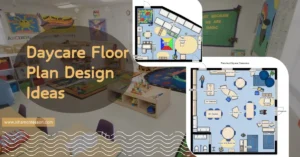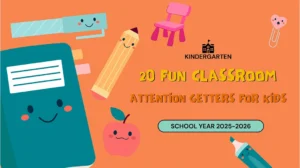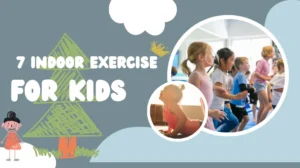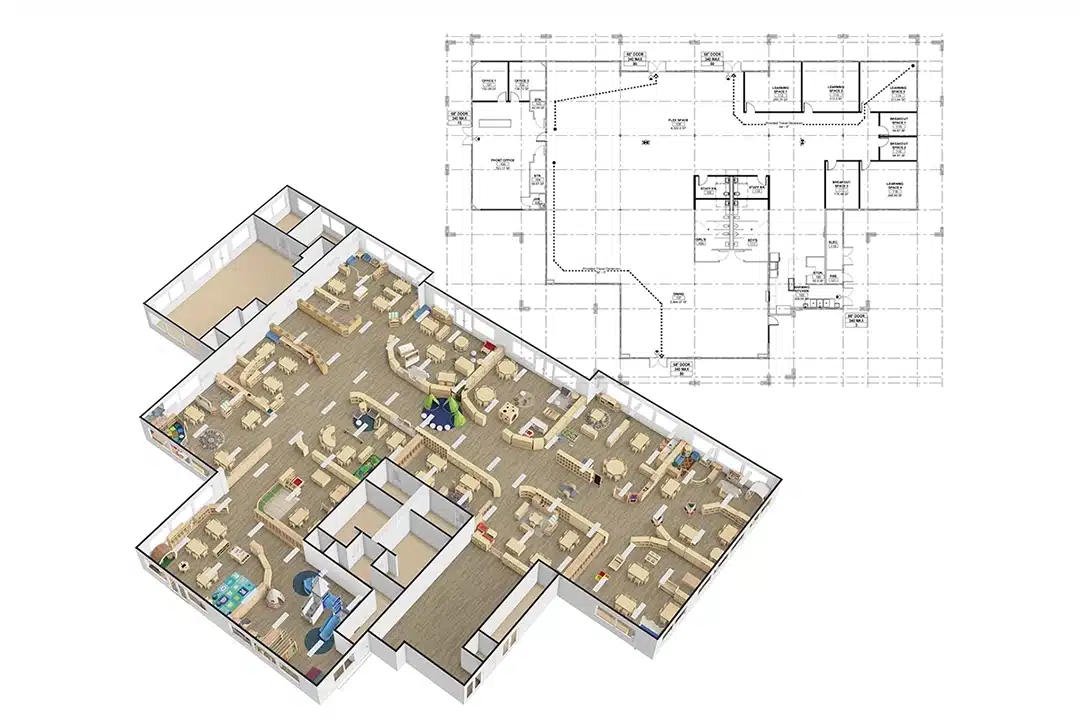Have you ever struggled to design fun, educational outdoor activities for preschoolers to get your kids outside and playing? Parents and teachers are always looking for ways to combine fun with learning. Outdoor play keeps kids active and helps them develop important skills.
Preschool outdoor activities inspire children to have fun and learn. Playing outdoors promotes mental health and self-confidence. Nature provides a playground that enhances creativity and concentration. Parents notice that children who spend time outdoors sleep better and are in better moods. Outdoor activities for preschoolers bring fun while teaching basic skills. Nature-based education enriches understanding and promotes emotional well-being. Embrace the outdoors and enjoy a healthier, happier childhood.
I’ll share 53 ideas in this article that keep preschoolers entertained and provide educational value. These activities are easy to set up, adapt to weather conditions, and cover essential skills. Let’s explore how you can turn the outdoors into your preschooler’s favorite classroom!
Importance of Outdoor Activities for Preschoolers
Outdoor play is more than just fun for preschoolers—it’s critical for their physical, emotional, and cognitive development. Here’s why:
1. Physical Benefits
Outdoor activities, especially those involving gross motor skills, help preschoolers develop strength, coordination, and endurance. Activities like running, climbing, and balancing build muscle tone and improve overall health. For example, outdoor gross motor activities for preschoolers, such as obstacle courses, boost physical development and encourage problem-solving and risk-taking. Seasonal activities, like outdoor winter activities for preschoolers, also offer new physical challenges, such as walking in the snow or sledding, which develop balance and coordination.
2. Emotional Benefits
Outdoor play is a natural stress reliever. Being surrounded by nature helps preschoolers feel calmer and more focused. Activities like outdoor autumn activities for preschoolers can introduce children to the beauty of changing seasons, teaching them to appreciate the world around them. Additionally, outdoor play fosters independence, allowing children to explore independently while building confidence. In summer, outdoor water activities for preschoolers not only provide fun but also help them overcome the fear of new sensory experiences like water splashing or floating.
3. Cognitive Benefits
Outdoor play encourages problem-solving, creativity, and curiosity. Outdoor cognitive activities challenge preschoolers to think critically about their environment. For example, during outdoor classroom activities for preschoolers, you can incorporate math lessons by counting trees, rocks, or bugs. Engaging in math outdoor activities for preschoolers, such as hopscotch with numbers or nature counting games, boosts their early numeracy skills.
4. Intellectual Stimulation
Nature offers endless opportunities for intellectual stimulation. Preschoolers naturally learn about the world around them through birdwatching or investigating bugs. These moments of engagement with nature help develop curiosity and expand knowledge about science, biology, and the environment.
5. Social Skills
Outdoor play is an excellent way for preschoolers to interact with peers and practice social skills. Whether working together on a group game or taking turns with equipment, children learn valuable communication, sharing, and empathy lessons.

How to Start Outdoor Activities for Preschoolers?
Starting outdoor activities for preschoolers doesn’t require expensive equipment or complicated setups. Here are some tips to get going:
1. Connect with Nature
Children are naturally curious about the world around them. Let them explore the environment by touching leaves, rocks, or trees. For instance, outdoor tree activities for preschoolers could involve climbing a low tree or creating bark rubbings. Observing insects or birds also encourages curiosity and wonder. Outdoor autumn activities for preschoolers, like collecting colorful leaves or creating nature collages, are simple but engaging ways to connect with the outdoors.
2. Be Guided by Your Child’s Interests
Does your child love water? Try setting up a water play activity for preschoolers during summer, like filling up buckets and using sponges to transfer water between them. If they’re fascinated by bugs, create a bug safari to explore different insect species. Tailoring activities to their interests keeps them engaged and eager to learn.
3. Safety First
Safety is essential when planning outdoor activities. Ensure the space is free of hazards, such as sharp objects or dangerous terrain. For preschoolers, outdoor ball activities should take place in a safe, open space where kids can run freely without obstacles. Always supervise closely to prevent accidents during more physically challenging tasks like climbing or balancing.
4. Be Prepared for Weather
The weather shouldn’t restrict outdoor play, but you do need to be prepared. On sunny days, ensure your preschooler is protected with sunscreen, hats, and plenty of water. Rainy days can still be fun! With the right rain gear, kids can splash in puddles or enjoy sensory activities like making mud pies. Teaching children to adapt to different environments and weather conditions is important, as well as making the outdoors an all-year-round playground.
5. Educational Integration
Incorporate lessons into outdoor play to combine learning with fun. For example, during outdoor spring activities for preschoolers, please encourage them to count how many flowers they find or name different colors in the garden. You can even create an outdoor classroom with simple lessons in nature.
6. Supervision and Interaction
While outdoor activities allow children to explore independently, they still require supervision. Join them during outdoor art activities for preschoolers, where they can paint or draw scenes from nature. This fosters interaction and opens up conversations about what they’re learning.
7. Consider Your Child’s Age and Abilities
Not all activities are suitable for every age group. Toddlers may enjoy simpler tasks like water play or outdoor color activities for preschoolers. At the same time, older children can tackle more complex activities like outdoor camping activities for preschoolers or fort building. Tailor the difficulty of the activities based on their abilities.

53 Fun and Educational Outdoor Activities for Preschoolers
Here are 53 engaging activities to help your preschooler develop key skills while having a blast outdoors.
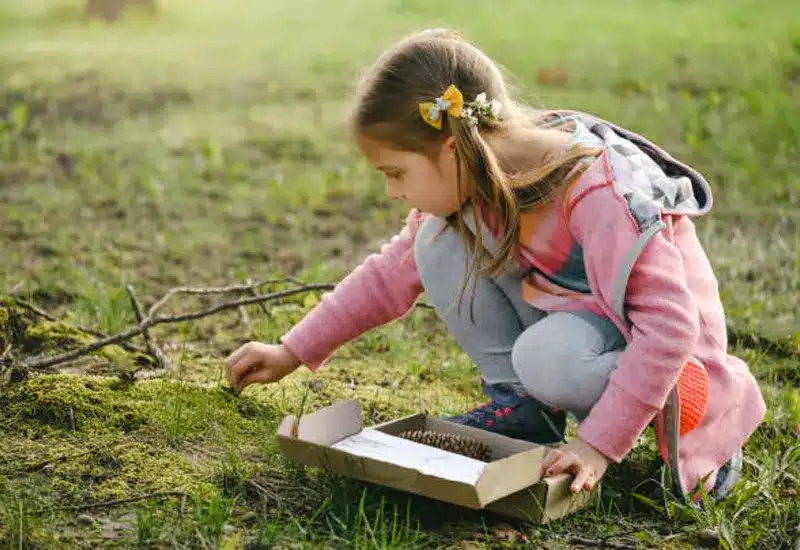
1. Nature Scavenger Hunt
Create a list of items like leaves, rocks, or flowers for kids to find. Scavenger hunts encourage observation and critical thinking as children look for specific colors, shapes, or textures.
Materials Needed:
- Paper and pencil (for making the list)
- A small basket or bag (for collecting items)
- A list of items to find (leaves, rocks, flowers, etc.)
How to Do It:
- Make a list of items for the kids to find (e.g., a red leaf, a smooth rock, a dandelion).
- Give each child a basket or bag to collect the items.
- Take them to a park, garden, or backyard and challenge them to find the listed items.
- You can turn it into a race to find all the items first or set time limits.
- Discuss the different items they find, discussing their colors, shapes, and textures.
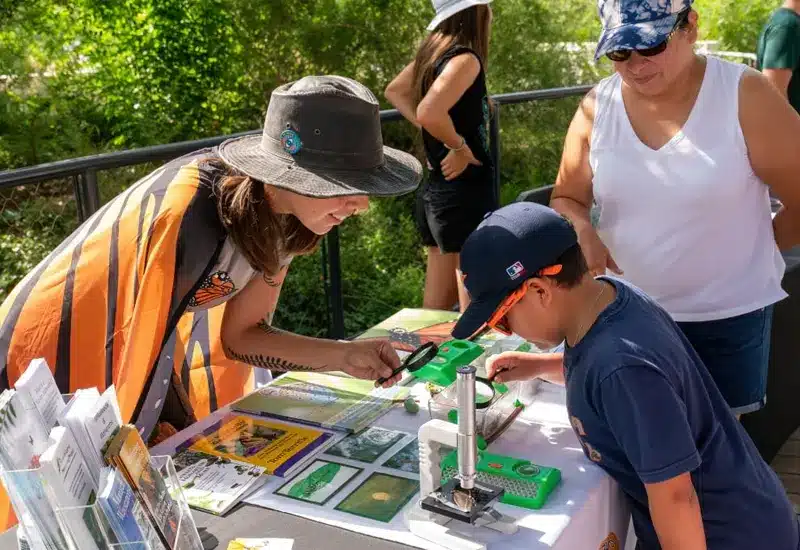
2. Bug Safari
Hand the kids a magnifying glass and take them on a bug hunt. Not only does this introduce them to the world of insects, but it also teaches them how to handle and respect nature’s smallest creatures.
Materials Needed:
- Magnifying glasses
- A container or jar (to safely capture bugs for observation)
- A notebook and pencil (for documenting findings)
How to Do It:
- Give each child a magnifying glass and a container to capture any bugs they might find.
- Head to an area with many bugs, such as a garden, park, or grassy area.
- Encourage the children to look under rocks, leaves, and flowers for different types of insects.
- Once a bug is found, have them carefully place it in the container for closer observation.
- Use the notebook to document the bugs, draw pictures or write down their names if possible.
- Discuss the different bugs they see, focusing on their roles in the ecosystem and how they interact with the environment.
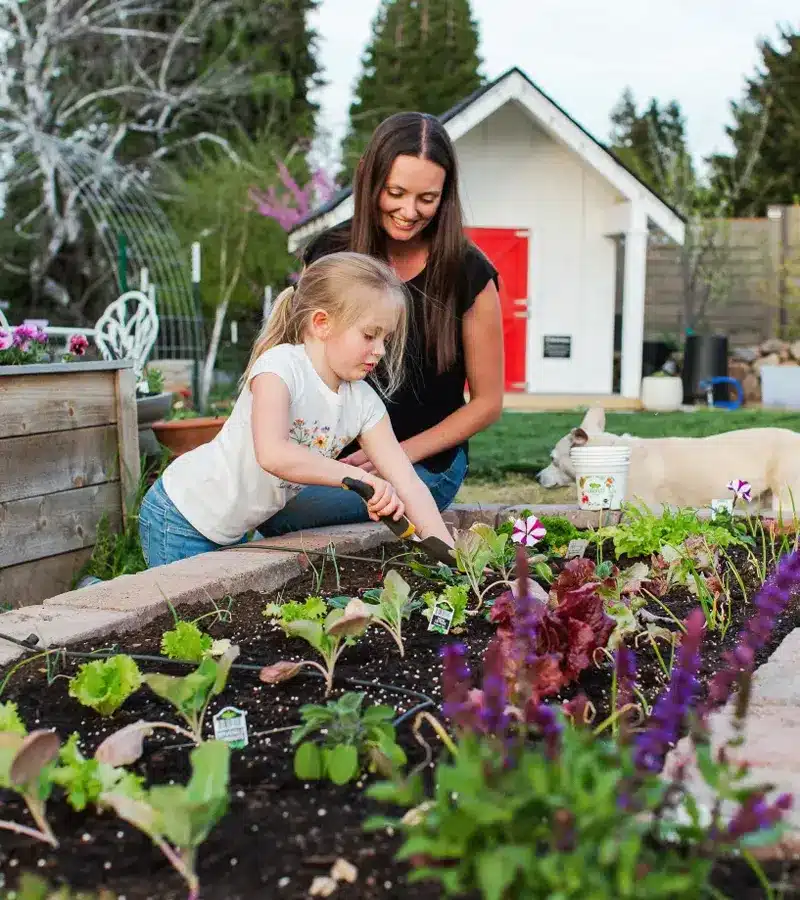
3. Gardening Together
Planting flowers, vegetables, or herbs can teach kids about plant life cycles, responsibility, and patience. Kids love getting their hands dirty, and watching something grow from seed to plant offers a rewarding, hands-on science lesson. Engage them by letting them choose what they want to grow, and use this time to teach them about the importance of water, sunlight, and soil in helping plants thrive.
Materials Needed:
- Seeds or seedlings (flowers, vegetables, herbs)
- Small gardening tools (trowel, spade, watering can)
- Pots or a garden bed
- Soil and compost
- A watering can or hose
How to Do It:
- Choose the seeds or seedlings you want to plant (e.g., marigolds, tomatoes, basil).
- Help the kids prepare the pots or garden beds by filling them with soil and compost.
- Show the kids how to plant the seeds by creating small holes, placing them in, and gently covering them with soil.
- Teach them about the importance of watering plants and sunlight.
- Water the plants together and talk about the plant life cycle, from seed to fully grown plant.
- Check on the plants regularly and encourage the children to care for them by watering them every day.
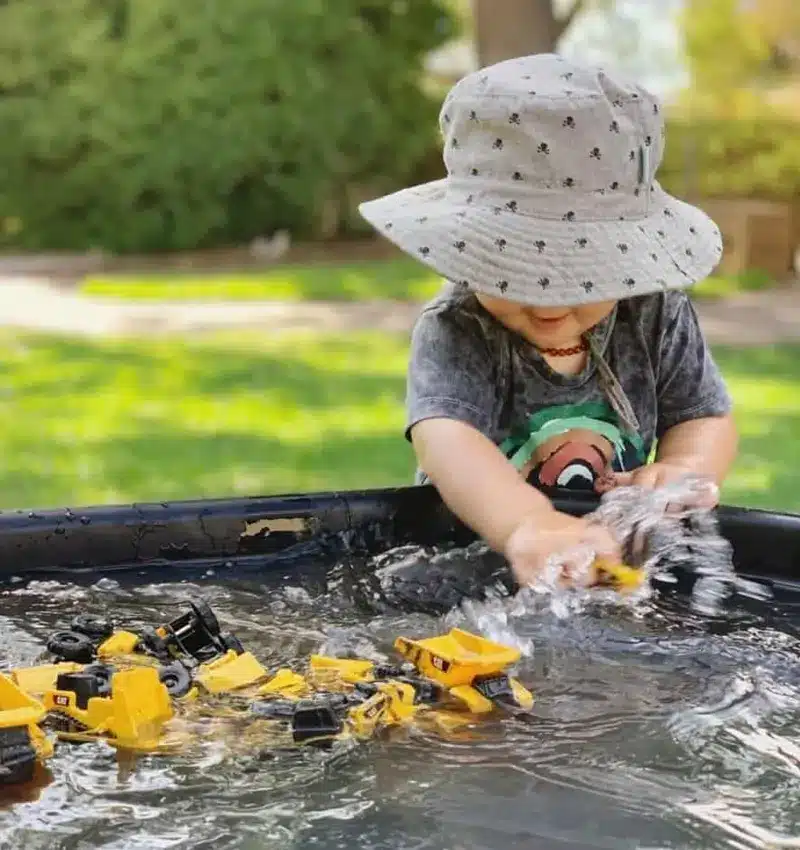
4. Water Play
Whether a simple water table or a small backyard pool, water play helps preschoolers explore properties like buoyancy and flow. Add toys or set up simple challenges like moving water from one container to another with a sponge. Water play introduces early physics concepts and sensory exploration in a fun, engaging way.
Materials Needed:
- Water table or small kiddie pool
- Plastic cups, spoons, or sponges
- Toy boats, rubber ducks, or other floating objects
- Towels (for drying off after play)
How to Do It:
- Fill the water table or kiddie pool with water.
- Provide various items like plastic cups, spoons, or sponges for the children to scoop, pour, or transfer water.
- Add toys like rubber ducks or toy boats to float in the water, or challenge the kids to move water from one container to another using sponges.
- Talk to them about buoyancy, water flow, and volume as they experiment with the water.
- Encourage them to create water-based games, such as races between floating objects or pouring water into specific containers.
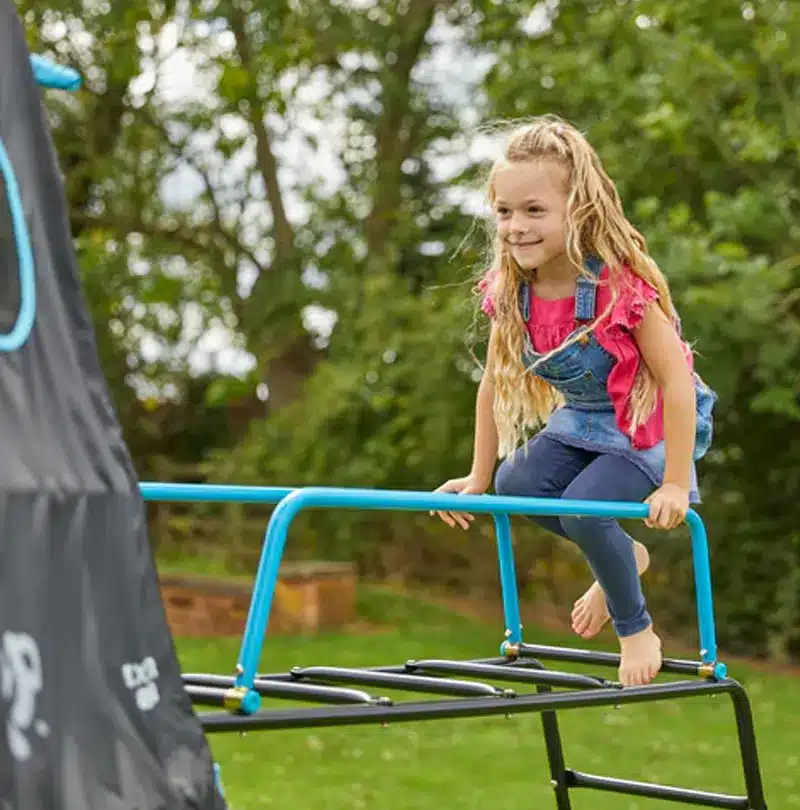
5. Obstacle Course Adventure
Create an obstacle course using cones, ropes, or natural materials like logs and stones. Not only does this burn energy, but it also develops motor skills, coordination, and balance. Plus, it encourages problem-solving as they figure out the best way to complete the course, whether they need to crawl, jump, or balance through each station.
Materials Needed:
- Cones, ropes, or natural materials (logs, stones, sticks)
- Hula hoops (optional)
- Ball or soft toys (optional)
- Stopwatch (optional for timed races)
How to Do It:
- Use cones, ropes, or natural materials to set up an obstacle course in your backyard or a large open area.
- Include stations like crawling under ropes, jumping through hula hoops, balancing on logs, or running between cones.
- Show the children how to navigate each obstacle and encourage them to try it themselves.
- You can add a competitive element by timing their runs, or simply let them take turns and cheer each other on.
- As they complete the course, encourage problem-solving by offering different challenges, such as balancing longer on the log or hopping faster through the cones.
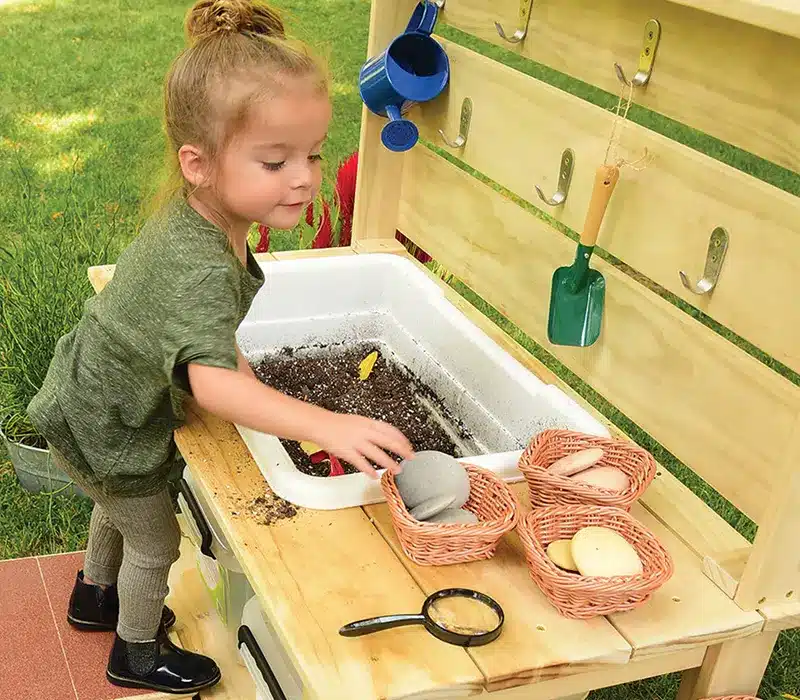
6. Mud Kitchen
Set up a small area in your yard for making mud pies using old kitchen utensils and natural materials. A mud kitchen encourages creativity and sensory play. Kids learn about textures and practice imaginative play as they “cook” outdoors, enhancing their tactile awareness and fine motor skills.
Materials Needed:
- Old kitchen utensils (plastic cups, spoons, bowls)
- Large plastic containers or buckets (for mud)
- Water hose or watering can (to make mud)
- Natural materials (leaves, sticks, stones, flowers)
How to Do It:
- Set up old kitchen utensils and containers in a safe, outdoor space to create a designated “mud kitchen” area.
- Use the water hose or watering can to mix water into the dirt, creating mud for cooking.
- Encourage your child to use the utensils to make mud pies, cakes, or other creations.
- Provide them with leaves, sticks, flowers, and stones to decorate their “dishes.”
- Let them use their imagination to cook, mix, and pretend while discussing the different textures of the mud and materials.
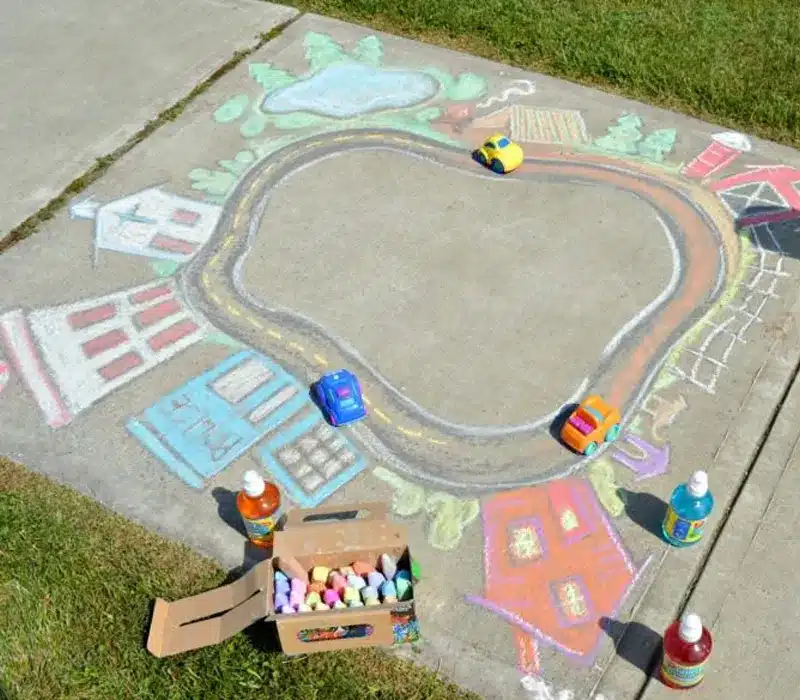
7. Chalk Art on Pavement
Sidewalk chalk is an inexpensive yet powerful tool for boosting creativity. You can challenge children to draw specific shapes, letters, or animals or let their imagination run wild. Please encourage them to recreate scenes from nature or practice writing their names in large, colorful letters, fostering early literacy skills.
Materials Needed:
- Sidewalk chalk (multiple colors)
- A large, flat outdoor surface (sidewalk, driveway, or pavement)
- A bucket of water (for cleaning up or creating textures)
How to Do It:
- Provide your preschooler with colorful sidewalk chalk and a clean, flat outdoor surface to draw on.
- Encourage them to draw simple shapes, letters, or animals. You can also challenge them to draw natural scenes, like flowers, trees, or the sun.
- Let them experiment with textures by dipping the chalk in water and using it to create different effects.
- Once they finish, allow them to admire their artwork or even take pictures to remember.
- Clean up with water or use the wet chalk to create new designs or blend the colors.
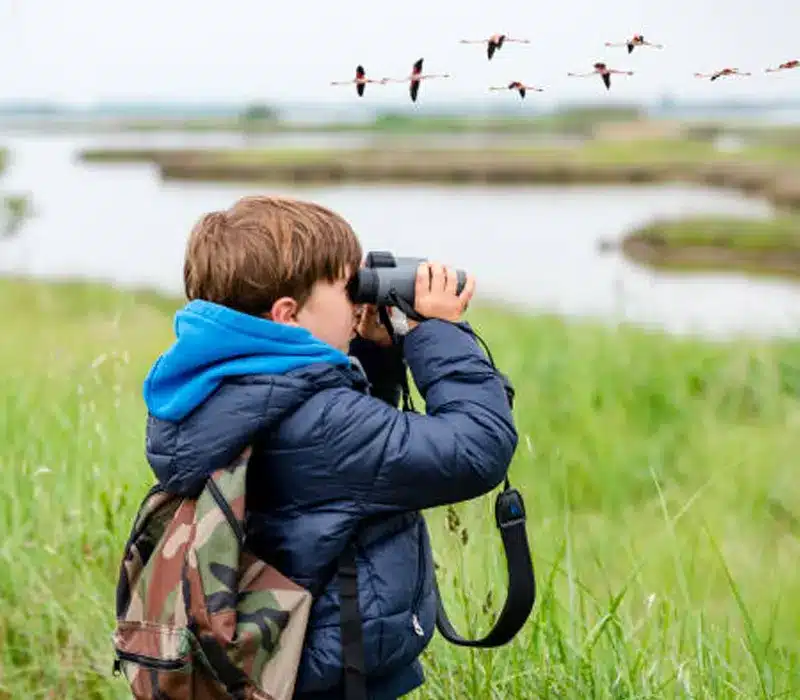
8. Bird Watching
Grab some binoculars and teach kids about local bird species. Encourage them to observe bird behavior and listen to different bird calls. Bird watching develops patience and sharpens observational skills, making it a peaceful yet educational outdoor activity. Engage children further by helping them keep a “bird journal” where they can document each species they identify.
Materials Needed:
- Binoculars
- Bird identification guide (book or app)
- Notebook or journal
- Pencil or colored pencils
How to Do It:
- Take your child to a quiet outdoor space like a park or garden with abundant birds.
- Give them binoculars and a bird identification guide (a book or a phone app) to help identify local bird species.
- Encourage them to quietly observe the birds, paying attention to their colors, behaviors, and calls.
- Help your child record their observations in a “bird journal,” noting the bird’s name, location, and other details, such as its song or movements.
- Discuss the different types of birds they spot and any fun facts you know about them.
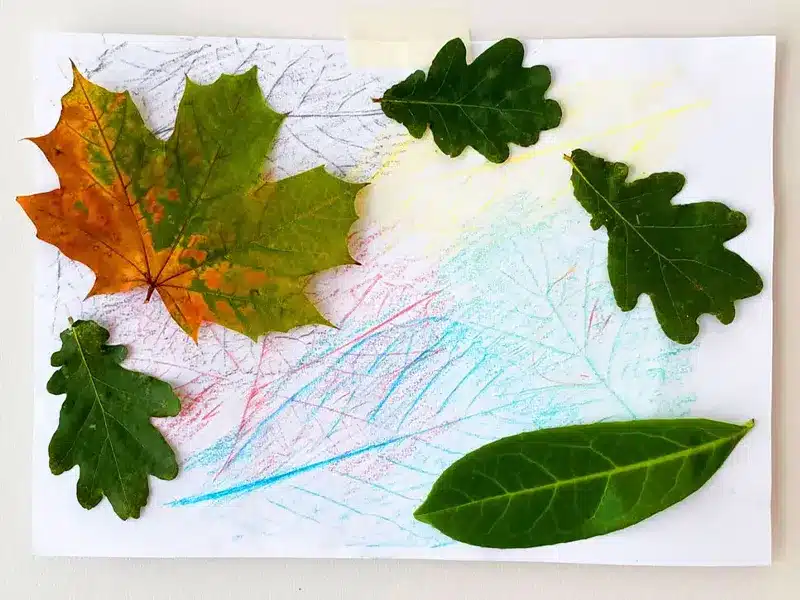
9. Leaf Rubbing
All you need is paper and crayons. Place a leaf under the paper and gently rub the crayon over it to reveal its texture and veins. This is a simple way to teach kids about botany while enhancing their fine motor skills. You can also encourage them to compare different leaves, discussing the variety in shape, size, and texture.
Materials Needed:
- Fresh leaves (various types)
- White paper
- Crayons (preferably wax crayons)
How to Do It:
- Gather various leaves with interesting shapes and textures from the yard or nearby park.
- Place a leaf under white paper, ensuring the veins are visible.
- Have your child gently rub the side of a crayon over the paper to reveal the leaf’s shape and texture.
- Encourage them to try this with different leaves and observe how each one’s texture and shape is unique.
- Discuss the differences in leaves and talk about the plants they come from, promoting a deeper understanding of botany.
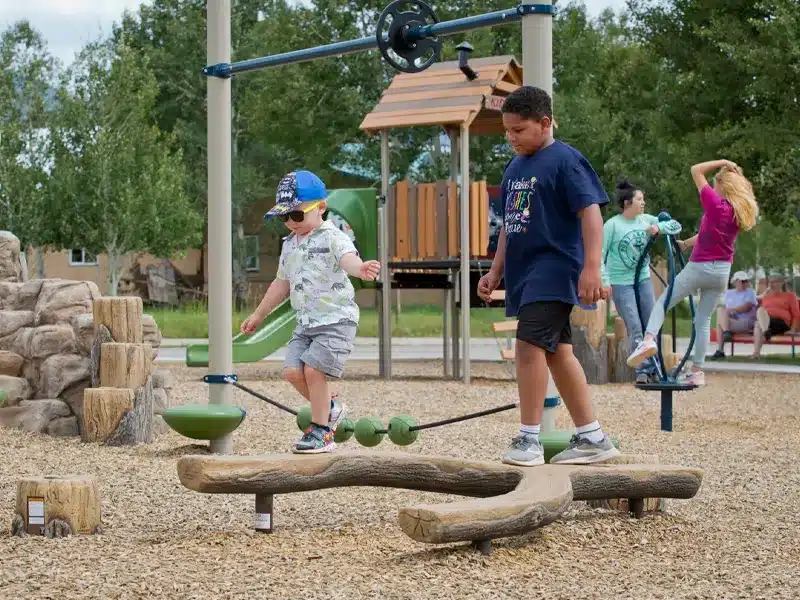
10. Balancing Beam Fun
Use a plank of wood or a fallen log as a balancing beam. This helps preschoolers practice balance and coordination. You can challenge them to walk forwards, backward, or even hop along the beam, developing their gross motor skills and spatial awareness.
Materials Needed:
- A plank of wood or a fallen log
- Soft mats or grass (for safety)
- Cones or markers (optional for added challenge)
How to Do It:
- Lay a wood plank or find a fallen log with a flat surface for your child to walk along.
- Show them how to balance by walking along the beam in a straight line. Start with their arms out to help with balance.
- Encourage them to walk forwards, then challenge them to walk backward or hop along the beam.
- To increase the challenge, you can add obstacles or markers along the beam, such as having them jump over small cones or stop at certain points.
- Make it a fun competition to see who can balance the longest or create a timed race along the beam.

11. Cloud Watching and Storytelling
Lay on the grass with the children and observe the clouds. Ask them to describe the shapes they see and create stories around those shapes. This activity encourages imagination, language development, and storytelling skills, as kids will have fun using their creativity to bring the clouds to life.
Materials Needed:
- A comfortable blanket or mat
- A clear sky or open outdoor area with visible clouds
- A notebook and pencil (optional for drawing or writing stories)
How to Do It:
- Lay down on a blanket or mat in a spot with a clear sky view.
- Encourage your child to look at the clouds and describe the shapes they see.
- Ask them what each cloud might be (e.g., a dinosaur, a castle) and create stories based on those shapes.
- If your child enjoys writing or drawing, have them sketch the clouds or write down their creative stories.
- Discuss different cloud types (like cumulus or stratus) to enhance their understanding of the natural world.

12. Rock Painting
Find some smooth stones and let the kids paint them bright colors or designs. This creative, low-cost activity helps develop fine motor skills. Kids can then use the painted rocks to create outdoor art or garden decorations, further enhancing their artistic expression.
Materials Needed:
- Smooth, clean rocks or pebbles
- Acrylic paints or washable paint
- Paintbrushes
- Palette or plates for mixing colors
- Water and paper towels (for cleaning)
How to Do It:
- Collect smooth stones or pebbles from a garden, park, or beach.
- Set up a painting station with paints, brushes, and palettes.
- Let your child paint the stones in bright colors, shapes, or designs. You can encourage them to paint animals, flowers, or abstract patterns.
- Allow the painted rocks to dry, and then use them as garden decorations, paperweights, or even gifts.
- Talk to your child about color mixing and the textures of the rocks as they paint.
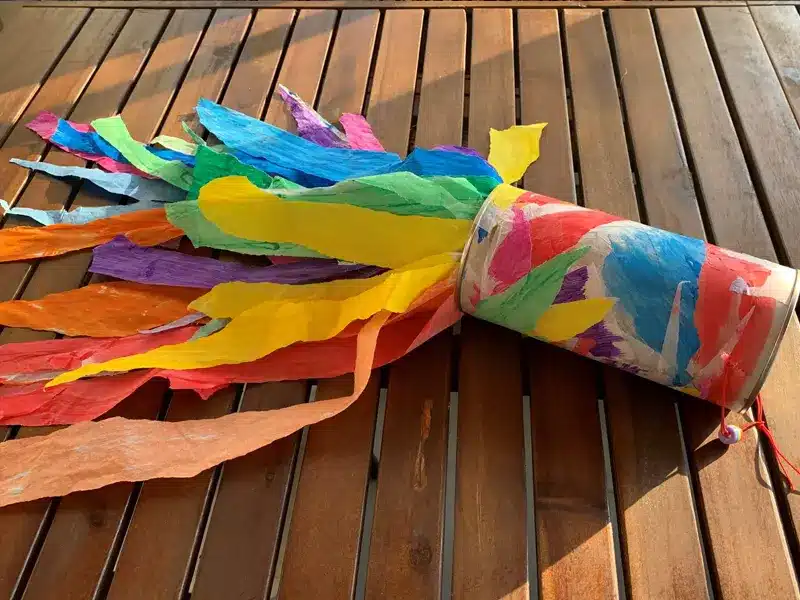
13. Wind Sock Craft
Use paper or fabric to create colorful wind socks, then watch them blow in the wind. This activity introduces children to basic science concepts like wind direction and speed while letting them express creativity through decorating their socks.
Materials Needed:
- Colored paper or fabric
- Scissors
- Glue or tape
- String or ribbon
- Hole punch (optional)
- Markers or stickers for decoration
How to Do It:
- Cut a rectangular piece of paper or fabric to create the body of the wind sock.
- Roll the paper or fabric into a tube and secure it with glue or tape to form the cylinder shape.
- Punch holes at the top and tie a string or ribbon to hang it from.
- Decorate the wind sock with markers, stickers, or other craft materials.
- Hang the wind sock outside on a windy day and watch it blow in the wind. Discuss how the direction and speed of the wind make the sock move.
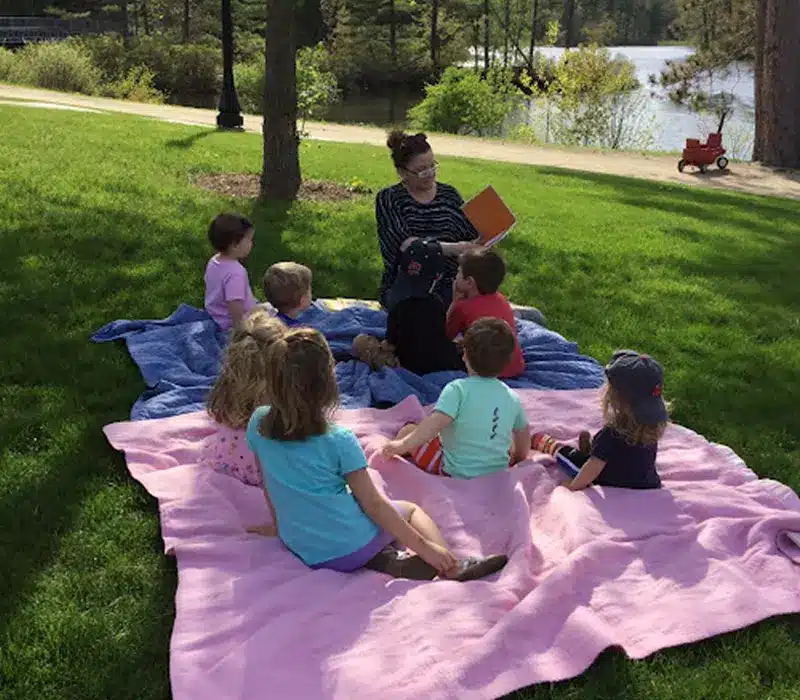
14. Outdoor Picnic and Story Time
Pack a lunch and take it outside for a picnic under the trees. Bring along a few storybooks and turn mealtime into an outdoor reading adventure. It’s a calm, pleasant way to promote literacy and healthy eating habits. Reading in nature also encourages peaceful, focused listening.
14. Outdoor Picnic and Story Time
Pack a lunch and take it outside for a picnic under the trees. Bring along a few storybooks and turn mealtime into an outdoor reading adventure. It’s a calm, pleasant way to promote literacy and healthy eating habits. Reading in nature also encourages peaceful, focused listening.
Materials Needed:
- A picnic blanket
- Healthy snacks or a packed lunch
- Storybooks or picture books
- A basket or cooler (to carry food and drinks)
How to Do It:
- Pack a picnic basket with healthy snacks, sandwiches, or fruit, and bring a blanket.
- Set the picnic under a tree, in a park, or in your backyard.
- After eating, bring out a few storybooks to read together.
- Encourage your child to listen to the story, ask questions, and discuss the pictures or characters.
- You can also engage your child by asking them to create their own stories based on what they see in their environment.
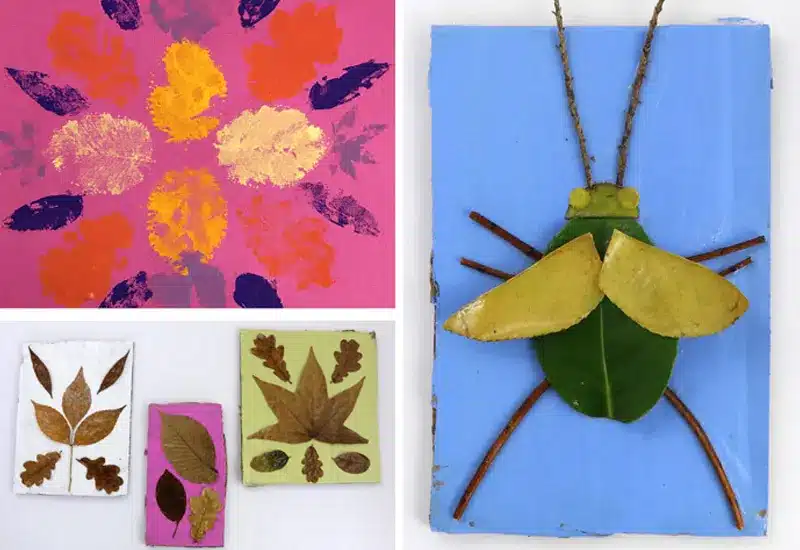
15. Nature Art
Collect leaves, flowers, and twigs to create a nature collage or mandala. This activity enhances creativity and provides a tactile experience as children explore different textures and shapes from the natural world.
Materials Needed:
- Leaves, flowers, twigs, rocks, or other natural materials
- A large piece of paper or cardboard
- Glue or tape
- Markers or crayons (optional for decorating)
How to Do It:
- Take your child to a natural space to collect leaves, flowers, twigs, and other interesting natural materials.
- Lay out a large piece of paper or cardboard as the base for the collage or mandala.
- Help your child arrange the natural materials into creative shapes or patterns on the paper.
- Once they’re happy with the design, help them glue or tape the materials into place.
- Use markers or crayons to add details to the art, such as drawing additional leaves or designs around the collage.
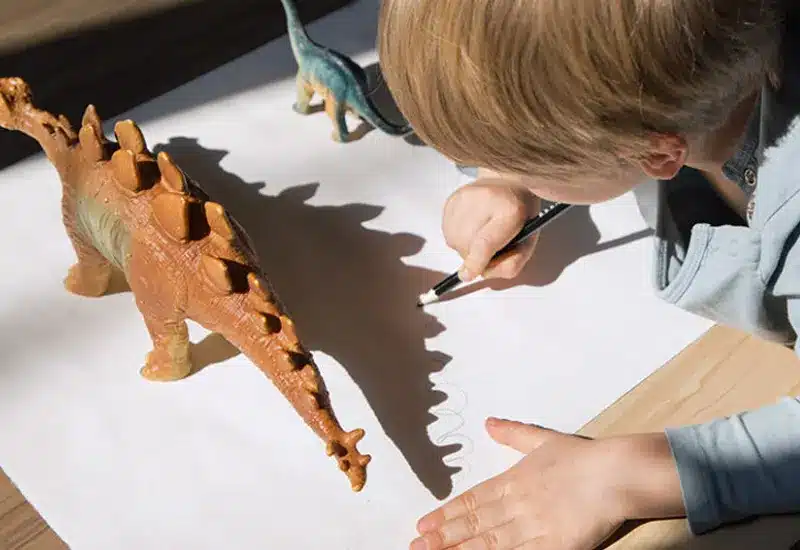
16. Shadow Play
On a sunny day, explore the concept of shadows by using objects or your body to cast shadows on the ground. Discuss why shadows change size throughout the day, helping preschoolers understand the basics of light and shadow.
Materials Needed:
- A sunny, open outdoor area
- Everyday objects (toys, sticks, hands)
- Chalk (for tracing shadows)
- Paper and pencil (optional for drawing)
How to Do It:
- Head outside on a sunny day and find an area with visible shadows.
- Encourage your child to use toys or their body to cast shadows on the ground.
- Use chalk to trace the shapes of the shadows, then compare them to the objects.
- Observe how the shadow moves or changes size depending on the sun’s position.
- Discuss the reason for these changes, introducing basic concepts of light and perspective.
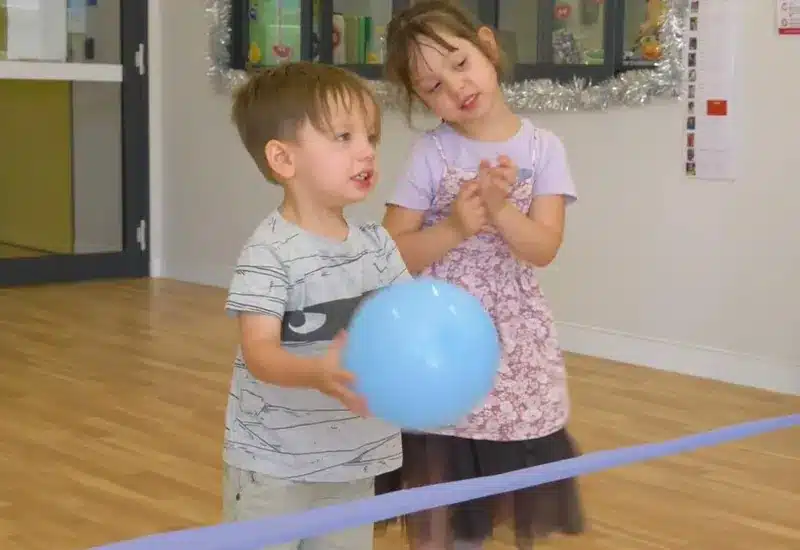
17. Balloon Volleyball
Stretch a rope or yarn between two points to create a net, and use balloons as the volleyball. This fun activity helps improve hand-eye coordination and introduces teamwork as children play together.
Materials Needed:
- Balloons
- Rope or yarn
- Two chairs, trees, or poles (to hold the rope)
- Open play area
How to Do It:
- Tie a rope or yarn between two stationary objects to act as a volleyball net.
- Blow up one or more balloons and explain the basic rules of volleyball: don’t let the balloon touch the ground.
- Divide the children into two teams on either side of the rope.
- Encourage them to hit the balloon back and forth over the net.
- Emphasize fun and teamwork, letting them create their variations of the game.

18. Building Forts
Gather natural materials like branches, leaves, and rocks to build a small outdoor fort. This activity sparks creativity, teamwork, and problem-solving as kids figure out how to structure their fort.
Materials Needed:
- Sticks and branches
- Leaves, rocks, or grass
- Blankets or tarps (optional)
- String or twine (optional for stability)
How to Do It:
- Choose a safe outdoor area with access to natural building materials.
- Show your child how to lean sticks or branches together to create a tent-like structure.
- Use rocks or logs to stabilize the base, and layer on leaves or grass for walls or roofing.
- If needed, add blankets or tarps to enhance the fort’s structure.
- Encourage your child to decorate the fort or create stories about who lives there.

19. Treasure Hunt
Hide small treasures around the yard and create a map or give clues for the children to follow. A treasure hunt encourages critical thinking and teamwork as they solve clues to find the prize.
Materials Needed:
- Small treasures or toys
- Paper and marker (for creating a treasure map or clues)
- A container or “treasure box”
- Optional: blindfold or costumes for fun
How to Do It:
- Hide small toys or treasures in different spots around your yard or park.
- Draw a simple map or write clues that lead from one location to the next.
- Give the map or first clue to the child and encourage them to work alone or in a group to find each item.
- Offer hints if needed, and celebrate when they find the final treasure.
- Make the game thematic (pirates, explorers) to increase excitement and imaginative play.
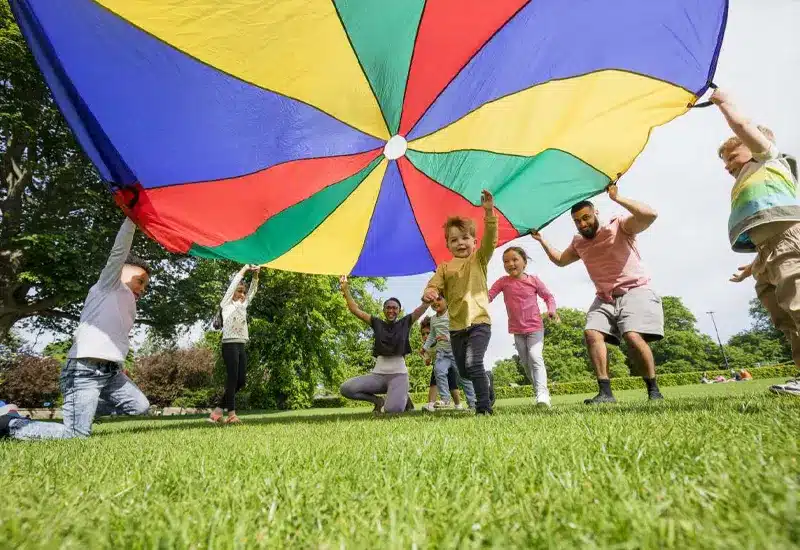
20. Parachute Games
If you have a parachute or large sheet, gather a group of children to play parachute games like bouncing balls on top or creating a “mushroom” by raising it high. This helps children develop social interaction and physical coordination.
Materials Needed:
- Parachute or large bed sheet
- Soft balls or lightweight objects (for bouncing)
- Open outdoor space
- A group of 4+ children
How to Do It:
- Have children evenly space themselves around the edges of the parachute or sheet.
- Show them how to lift and lower the fabric together to create airflow underneath.
- Try different games:
- Popcorn: Toss balls onto the parachute and shake to bounce them.
- Mushroom: Raise the parachute together and duck underneath as it floats down.
- Color call: When a color or name is called, those players run under and switch places.
- Emphasize listening, cooperation, and fun throughout the activity.
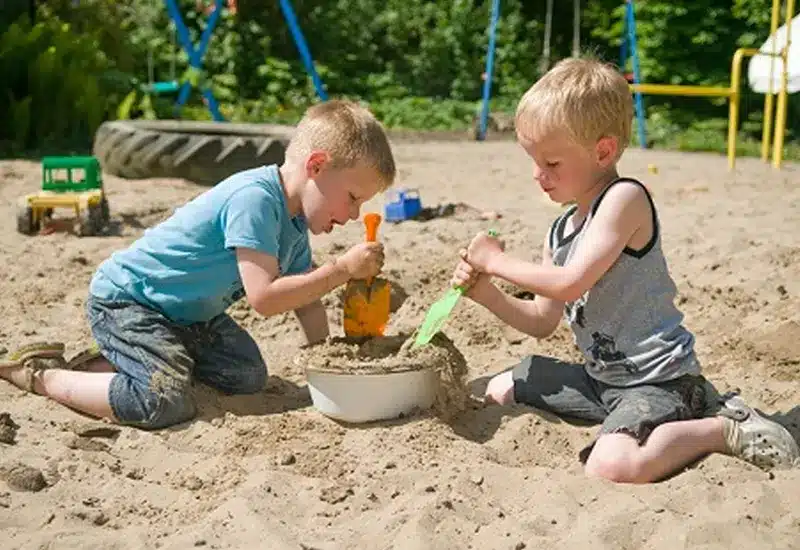
21. Sand Play
Bring out a bucket of sand and some toys, and let the children build sandcastles or dig tunnels. This activity fosters creativity and introduces early engineering skills. You can also turn sand play into an educational game by having them count buried objects or create shapes with molds.
Materials Needed:
- Bucket of clean play sand
- Shovels, scoops, and rakes
- Sand molds (various shapes)
- Small toys or objects to bury
How to Do It:
- Set up a sandpit or fill a large container with clean play sand.
- Provide tools like shovels, scoops, and molds for building.
- Let children dig, build, and shape sand structures like castles or roads.
- Hide small toys or objects in the sand and have them search and count what they find.
- Encourage them to describe their building and discuss concepts like height, shape, and stability.
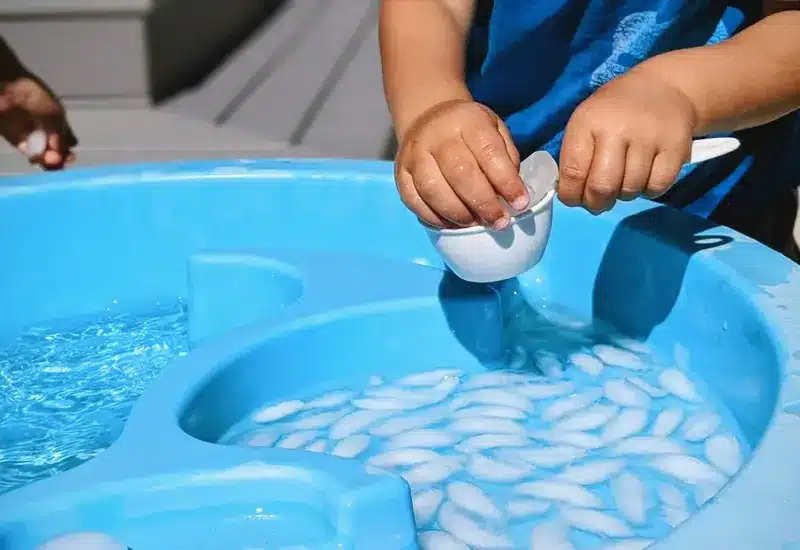
22. Ice Play on a Hot Day
On a warm day, fill containers with water and freeze them. Once solid, take the ice blocks outside and let the children experiment with melting them using water or natural materials.
Materials Needed:
- Ice blocks (frozen in containers of various sizes)
- Salt (optional, to speed up melting)
- Natural materials (leaves, twigs, stones)
- Eye droppers or squeeze bottles with warm water
How to Do It:
- Freeze water in various containers overnight to create large ice blocks.
- Bring the blocks outside and place them in trays or on the ground.
- Give children warm water, salt, or natural materials to experiment with melting.
- Encourage them to describe the melting process and how different materials affect it.
- Let them feel the temperature and observe changes in the ice over time.

23. Paint with Water
Give children large brushes and containers of water, and let them “paint” the driveway or walls. As the water evaporates, you can introduce a discussion about the water cycle and the concept of evaporation.
Materials Needed:
- Large paintbrushes or rollers
- Containers or buckets of water
- Outdoor surface (pavement, walls, fences)
How to Do It:
- Fill buckets or containers with clean water.
- Give each child a brush or roller and let them dip and paint on pavement or fences.
- Watch the water darken the surface, slowly disappearing as it dries.
- Talk about how water evaporates and where it goes.
- Encourage them to “draw” pictures or practice writing letters or numbers with water.

24. Nature Bracelet Crafting
Wrap a piece of tape around your child’s wrist, sticky side out, and go on a nature walk collecting small flowers, leaves, and grasses to stick on their “bracelet.” This fun craft promotes observation of the natural world and helps children identify different plants and textures.
Materials Needed:
- Masking tape or painter’s tape
- Small scissors (optional)
- Access to a natural area with leaves, flowers, and grass
How to Do It:
- Wrap a piece of tape loosely around your child’s wrist with the sticky side facing out.
- Go on a nature walk and encourage your child to collect small, lightweight items like flower petals, blades of grass, and tiny leaves.
- Help them press the items onto the tape as they walk, building a colorful bracelet.
- Talk about each item they choose—its name, color, texture, and scent.
- Once done, admire the unique bracelet as a natural keepsake of the day.
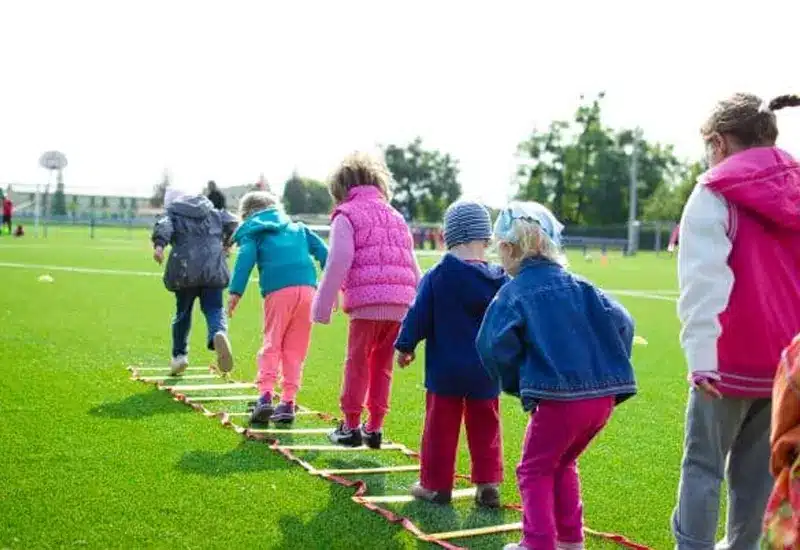
25. Follow the Leader
Turn an outdoor walk or play session into a “Follow the Leader” game, where the child imitates your movements. Add fun actions like hopping, skipping, or spinning to keep the game engaging. This will promote listening skills, coordination, and physical activity.
Materials Needed:
- Open space (yard, park, or trail)
- Optional props (scarves, hats, sticks for added fun)
- No other materials required
How to Do It:
- Start by leading your child through a path or across the yard while doing exaggerated movements.
- Include hopping on one foot, crawling, skipping, spinning, or tiptoeing.
- Encourage them to copy exactly what you do as they follow.
- Switch roles and let your child be the leader.
- Add themed versions (animal walks, superhero moves) to keep it exciting and imaginative.

26. Dinosaur Dig
Bury small dinosaur toys in a sandbox and let children excavate them using toy shovels or brushes. This activity introduces early archaeology concepts and encourages patience and problem-solving as they carefully dig out their finds.
Materials Needed:
- Sandbox or large container with sand
- Small plastic dinosaur toys
- Toy shovels, paintbrushes, or spoons
- Small trays or bowls for collected “fossils”
How to Do It:
- Bury the dinosaur toys in different sand depths before the activity begins.
- Give your child tools like brushes and shovels to excavate the buried items.
- Encourage them to dig carefully, like real paleontologists, and place their discoveries in trays.
- Talk about each dinosaur they find, naming species or inventing fun facts.
- Optionally, create a simple field journal for them to draw or describe their finds.
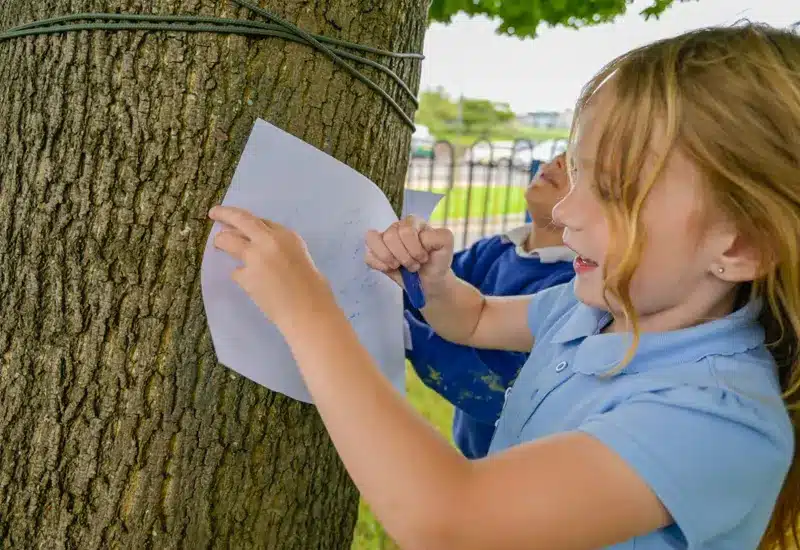
27. Tree Bark Rubbing
Similar to leaf rubbing, use paper and crayons to capture the texture of tree bark. This introduces children to the diversity of trees while sharpening their observation skills.
Materials Needed:
- White paper
- Crayons (with paper removed for easier rubbing)
- Tape (optional to secure the paper)
- Access to trees with textured bark
How to Do It:
- Find trees with rough or interesting bark textures in a park or backyard.
- Place the paper against the tree trunk and gently rub the crayon sideways over the paper.
- Secure the paper with tape if needed for stability.
- Observe and compare the different bark patterns made from various trees.
- Discuss the tree’s features and encourage your child to guess its age or species.

28. Jump Rope Challenges
Set up jump rope games or challenges if your child is old enough. See how many jumps they can complete in a row, or teach them simple rhymes to chant while jumping. This improves coordination, rhythm, and physical endurance.
Materials Needed:
- Child-sized jump rope
- Open flat surface (sidewalk, driveway, grass)
- Optional: chalk to mark starting lines or scores
How to Do It:
- Start by showing your child how to hold and swing the jump rope.
- Let them practice basic jumping techniques with both feet.
- Introduce counting challenges: “How many jumps can you do without stopping?”
- Teach traditional rhymes to make it rhythmic and engaging.
- Track their progress over time to celebrate improvement in coordination.
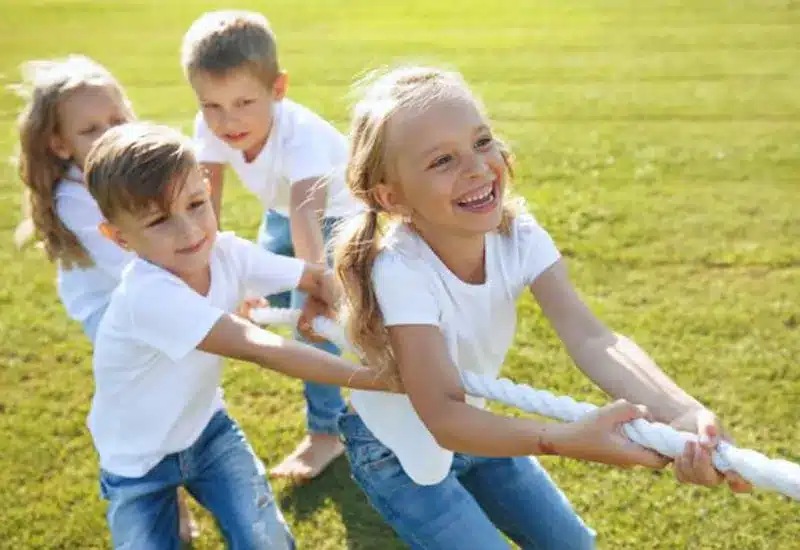
29. Tug of War
Using a long rope, play a gentle game of tug-of-war. This simple game promotes teamwork and coordination and builds strength. Make sure to supervise closely to ensure the game stays safe and fun.
Materials Needed:
- Sturdy rope (long enough for both sides)
- Soft grassy area (to prevent injury)
- Marking cone or tape (to show the center)
How to Do It:
- Divide participants into two small teams or let the child play with an adult.
- Mark the center of the rope and a line on the ground to signal the win zone.
- On “go,” both sides pull the rope, trying to pull the other past the line.
- Keep the tone playful, focusing on effort and fun, not just winning.
- Rotate team members and encourage cheering and high-fives after each round.

30. Outdoor Puzzles
Bring oversized floor puzzles outside and work on them in the fresh air. Completing puzzles in an outdoor environment combines cognitive development with sensory experiences, enhancing problem-solving and motor skills.
Materials Needed:
- Large, durable puzzle pieces (floor puzzles or foam puzzles)
- Picnic blanket or mat
- Flat, shaded outdoor area
How to Do It:
- Lay out a blanket or mat in a clean, flat area outdoors.
- Spread the puzzle pieces and have your child identify edge pieces or colors.
- Work together to complete the puzzle, talking through patterns and images.
- Introduce puzzle-related vocabulary like “corners,” “sides,” “fit,” and “match.”
- Celebrate the completed puzzle and consider timing the activity to track improvements.
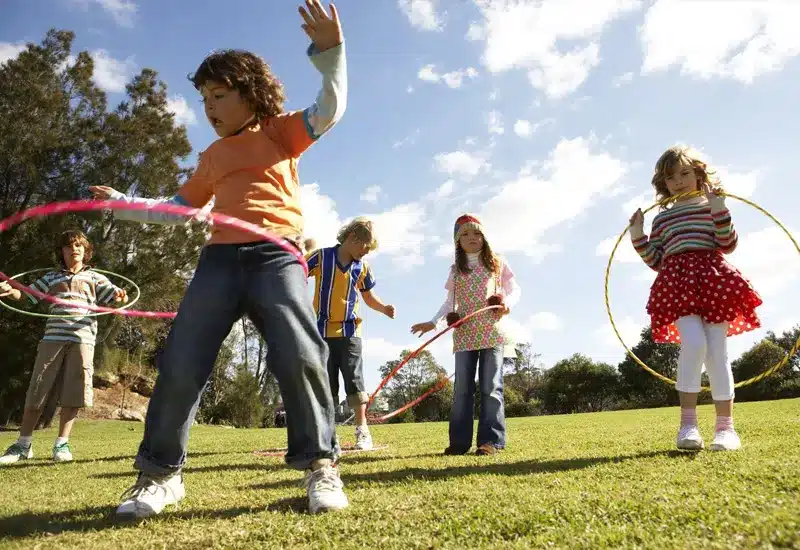
31. Hula Hoop
Hula hooping is an exciting and active game that helps preschoolers develop balance and coordination. As children twist their hips to keep the hoop spinning, they practice rhythm, timing, and movement, all while having fun outdoors.
Materials Needed:
- Hula hoop
How to Do It:
- Give your preschooler a hula hoop and demonstrate how to place it around their waist.
- Encourage them to twist their body to keep the hoop spinning for as long as possible.
- You can add challenges by having them hula hoop for longer periods or while jumping in place, or create a mini obstacle course where they have to hula hoop at different stations.
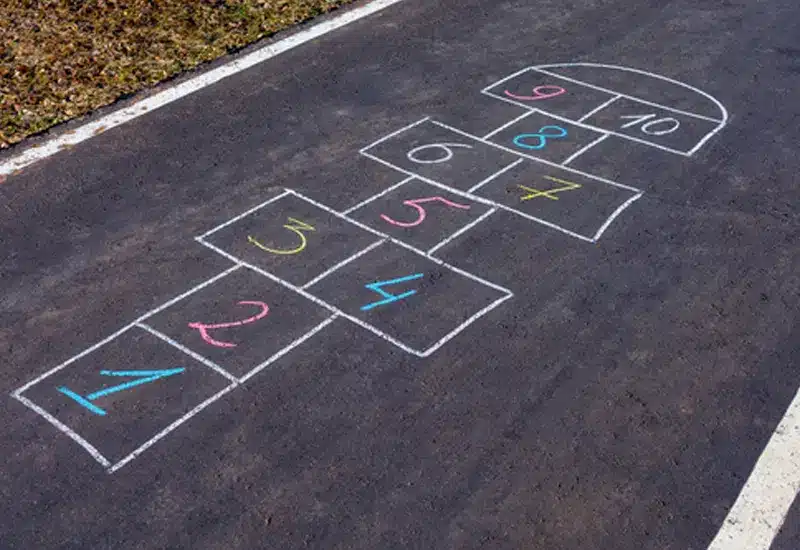
32. Hopscotch
Hopscotch is a classic outdoor game that combines physical exercise with cognitive development. Preschoolers practice hopping on one foot, jumping, and learning to count in this fun and engaging activity.
Materials Needed:
- Chalk (if using sidewalk)
- Hopscotch mat (if using a pre-made version)
How to Do It:
- Draw a chalk hopscotch grid on the ground or set up a pre-made mat.
- Show your preschoolers how to hop from one square to the next, making sure they jump on one foot or two, depending on the square layout.
- You can add counting exercises by having them say numbers aloud as they hop and challenge them to hop faster or with their eyes closed.
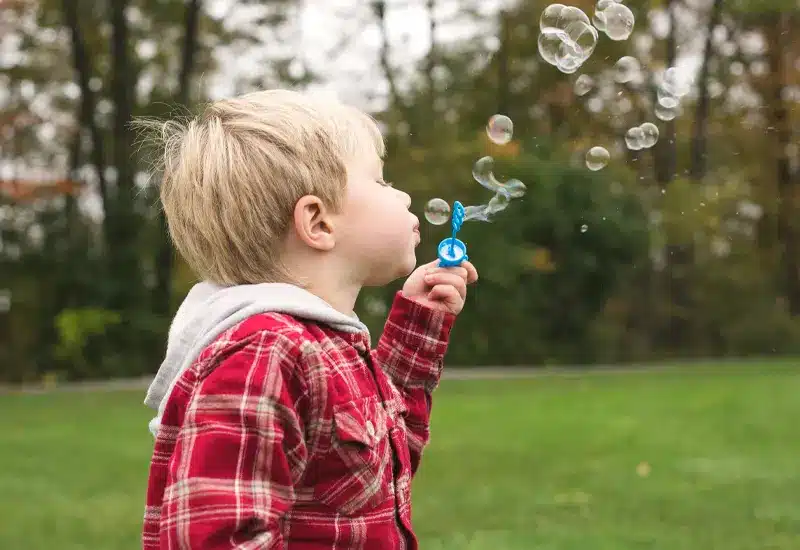
33. Blow Bubbles
Blowing bubbles is a relaxing and fun outdoor activity that helps children practice breath control, concentration, and eye coordination. It’s also a great sensory experience for preschoolers as they watch the bubbles float and pop around them.
Materials Needed:
- Bubble solution
- Bubble wands
How to Do It:
- Dip the bubble wand into the bubble solution.
- Show your child how to blow into the wand to create bubbles gently.
- Encourage your child to chase and pop the bubbles or to see who can blow the biggest or most bubbles.
- You can also experiment with different bubble wands to create bubbles of various shapes and sizes.

34. Bicycle, Tricycle or Scooter Race
Riding a bicycle, tricycle, or scooter is not only fun but also promotes physical fitness. It helps preschoolers build strength, coordination, and balance, all while encouraging outdoor play and healthy competition.
Materials Needed:
- Bicycle, tricycle, or scooter
- Helmets (for safety)
- Cones or markers (optional for creating a race track)
How to Do It:
- Set up a race track or course using cones or natural markers like trees or bushes.
- Have your preschooler race their bike, tricycle, or scooter along the course.
- You can time the race to see how quickly they can complete the course or encourage them to beat their time.
- Make it more fun by having a “cheering” competition or team playing.
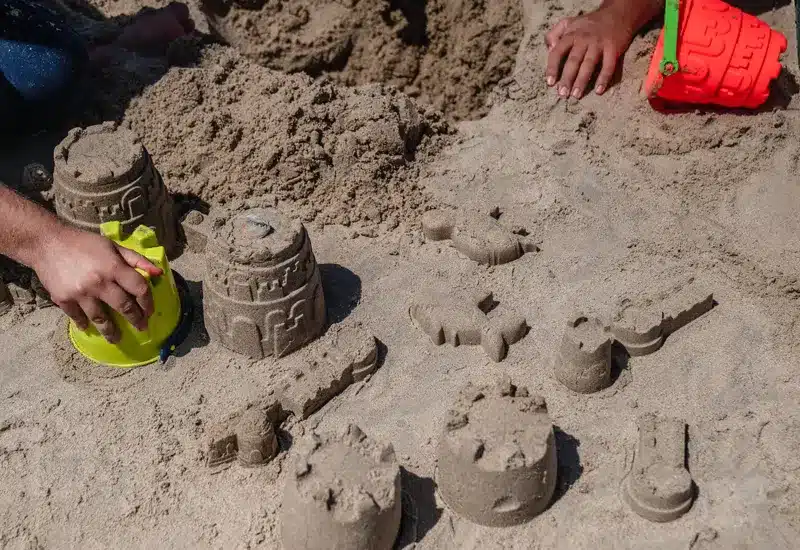
35. Build Sand or Mud Castles
Building sand or mud castles is a creative activity that promotes imaginative play and fine motor skills. It encourages preschoolers to think about shapes, textures, and the properties of sand and mud while having fun with their hands.
Materials Needed:
- Sand or mud
- Small buckets
- Shovels
- Plastic molds (optional)
- Water (to help with molding the sand or mud)
How to Do It:
- Head to the beach or a sandbox, or create a mud area in your backyard.
- Provide your child with a bucket and shovel and show them how to fill it with sand or mud.
- Encourage them to flip the bucket over to create a base and build walls and towers to form their castle.
- Use molds to shape the sand or mud into different designs, or let your child’s imagination run wild with their creations.
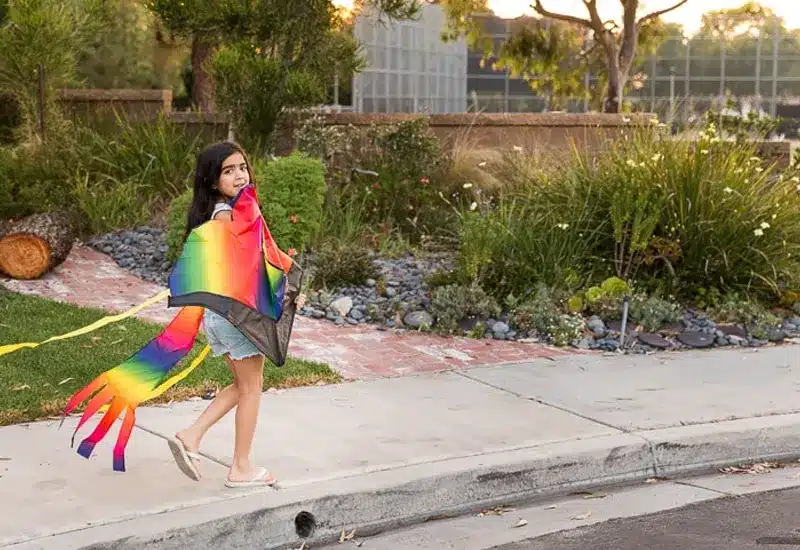
36. Fly a Kite
Flying a kite is a timeless outdoor activity that introduces preschoolers to the science of wind and motion. It teaches them about aerodynamics while giving them the chance to run, jump, and experience the thrill of watching a kite soar high in the sky.
Materials Needed:
- Kite
- Open, windy space
- String
How to Do It:
- Take your kite to an open area with plenty of wind, such as a park or beach.
- Show your preschoolers how to hold the string and help them launch the kite by running to catch the wind.
- Let them take turns flying the kite, holding onto the string and watching it fly high in the sky.
- You can also introduce different tricks by encouraging them to fly the kite in circles or loops.

37. Catch Bugs with a Bug Trap
Catching bugs with a bug trap encourages preschoolers to explore their environment and learn about the small creatures that inhabit it. It’s a great way to teach kids about insects, their habitats, and their roles in nature.
Materials Needed:
- Bug trap (or jar with holes)
- Magnifying glass
- Paper and pencil (for drawing or recording discoveries)
How to Do It:
- Use a bug trap, or take a jar with holes in the lid to catch bugs without harming them.
- Encourage your child to explore the garden, park, or backyard to find insects like ants, ladybugs, or butterflies.
- Once they catch a bug, use the magnifying glass to observe its features closely.
- Have them draw the bugs they find or make a simple bug journal to document each discovery.
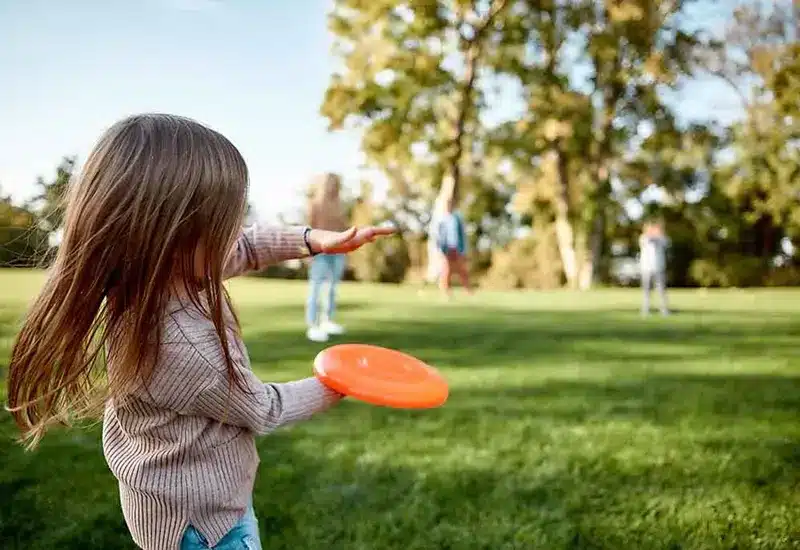
38. Play Frisbee
Frisbee is an excellent way to engage preschoolers in outdoor play while improving hand-eye coordination, motor skills, and teamwork. The game involves throwing and catching a flying disc, which provides a fun challenge and promotes physical fitness.
Materials Needed:
- Frisbee
- Open space (park, yard, etc.)
How to Do It:
- Start by showing your preschooler how to hold the frisbee and how to throw it in a gentle arc.
- Play catch by tossing the frisbee back and forth, encouraging your child to catch it with both hands or one hand.
- You can increase the difficulty by playing at a distance or having your child throw the frisbee to a target.
- Make the game more engaging by creating challenges like accuracy or distance goals.

39. Have a Water Balloon Battle
Water balloon battles are an exciting and refreshing way for preschoolers to stay active during hot weather. It helps improve hand-eye coordination, agility, and social skills as children run, throw, and dodge water balloons.
Materials Needed:
- Water balloons
- A bucket or container to fill the balloons
- Towels or extra clothes for drying
How to Do It:
- Fill the water balloons in advance and place them in a bucket or container.
- Divide the balloons into teams, or let your preschooler have fun throwing them in any direction.
- Encourage your child to avoid getting hit by the water balloons while also trying to splash others.
- You can introduce team play by having one team “attack” and another “defend,” or make it a race to see who can pop the most balloons.
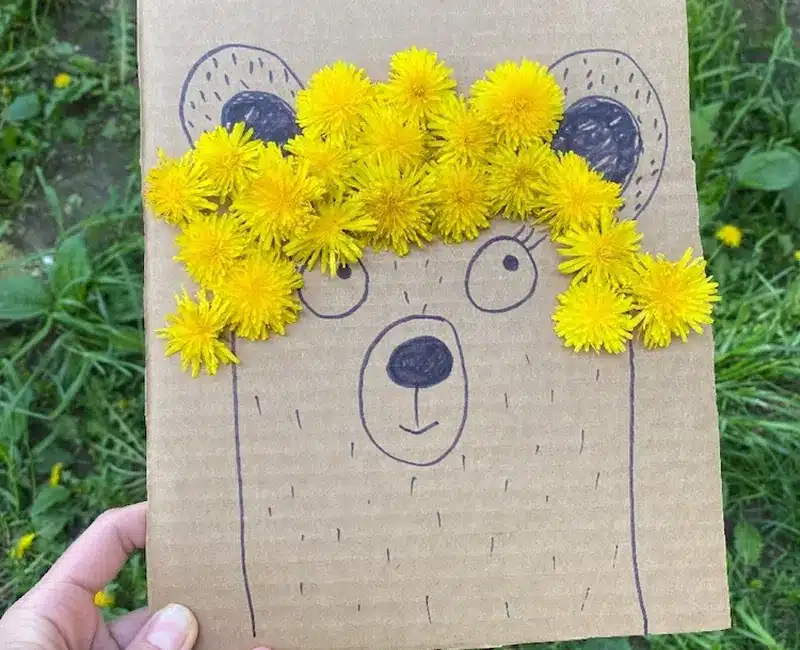
40. Pick Flowers and Make Bouquets
Picking flowers and creating bouquets is a lovely way to connect preschoolers with nature. It teaches them about different flower species, colors, and the concept of arranging things creatively. It also encourages fine motor skills as children pick and organize the flowers.
Materials Needed:
- Fresh flowers (wildflowers, garden flowers, or purchased)
- Small vase or jar (for displaying bouquets)
- Ribbon or string (optional)
How to Do It:
- Take your preschooler to a garden, park, or wildflower area where they can safely pick flowers.
- Encourage them to gently pluck the flowers while explaining the importance of not damaging the plant.
- Once they have a variety of flowers, show them how to arrange them into a simple bouquet.
- If desired, tie the bouquet with a ribbon or string and place it in a vase to display indoors.
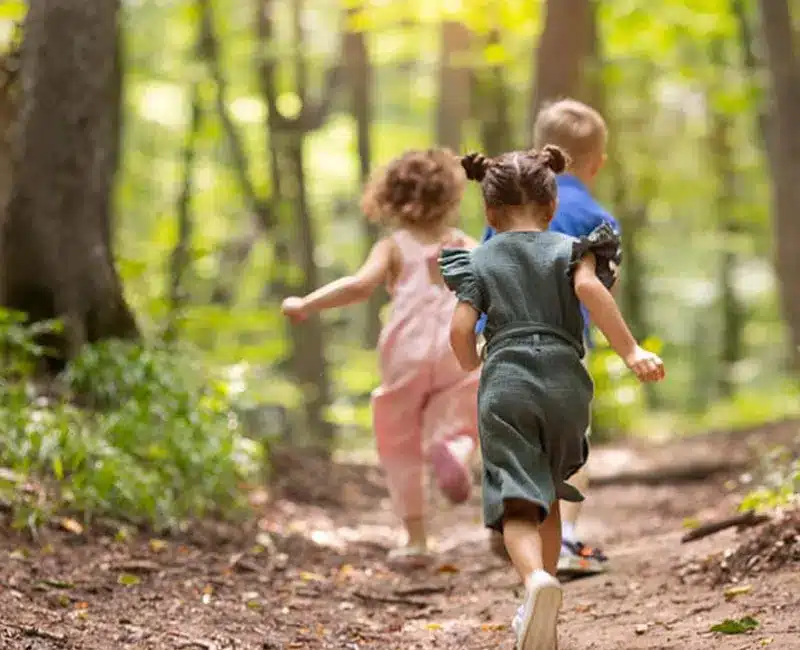
41. Take a Nature Walk
A nature walk is a peaceful and educational outdoor activity that encourages preschoolers to observe and appreciate the natural world around them. During a walk, they can discover different plants, animals, and other natural elements, helping them develop a sense of curiosity and environmental awareness.
Materials Needed:
- Comfortable walking shoes
- A small nature journal (optional)
- Binoculars (optional)
How to Do It:
- Choose a safe and accessible nature trail, park, or garden to explore.
- Encourage your child to look around and observe the plants, trees, animals, and insects they see along the way.
- If desired, provide a small nature journal where they can draw or write down what they observe.
- You can also bring binoculars to spot birds or faraway creatures, adding fun to the walk.

42. Play Leap Frog
Leap Frog is a fun and energetic outdoor game that promotes physical development, balance, and coordination. It’s a great way to get preschoolers moving and laughing while engaging their muscles in a playful activity.
Materials Needed:
- No materials needed (just open space)
How to Do It:
- Have one child crouch down while the other “leaps” over them.
- Once the child has leaped, they should switch roles, with the previous leaper crouching down to be leaped over.
- To make it more exciting, increase the distance between the leaper and the crouching person, or add a challenge by hopping on one foot.
- You can also create a race to see who can leap over the most people or objects in a set time.
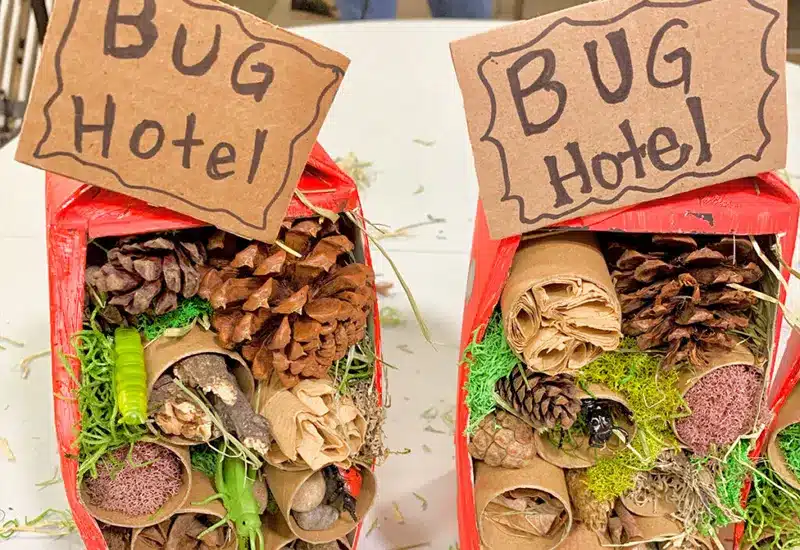
43. Make a Bug House
Building a bug house is a creative way for preschoolers to engage with nature and learn about different insect species. It allows observing bugs and their natural behaviors in a safe, controlled environment.
Materials Needed:
- Small wooden box or container
- Natural materials like twigs, leaves, pinecones
- Small pieces of bark or cardboard
- Magnifying glass
How to Do It:
- Begin by providing your child with a small box or container to use as the base for the bug house.
- Have them collect materials around the yard, such as twigs, leaves, and pinecones, to fill the house and create small nooks for bugs to hide in.
- Once the bug house is built, place it in a sheltered outdoor area and encourage your preschooler to observe which bugs come to explore the house.
- Use a magnifying glass to look at the bugs up close and discuss their roles in the environment.
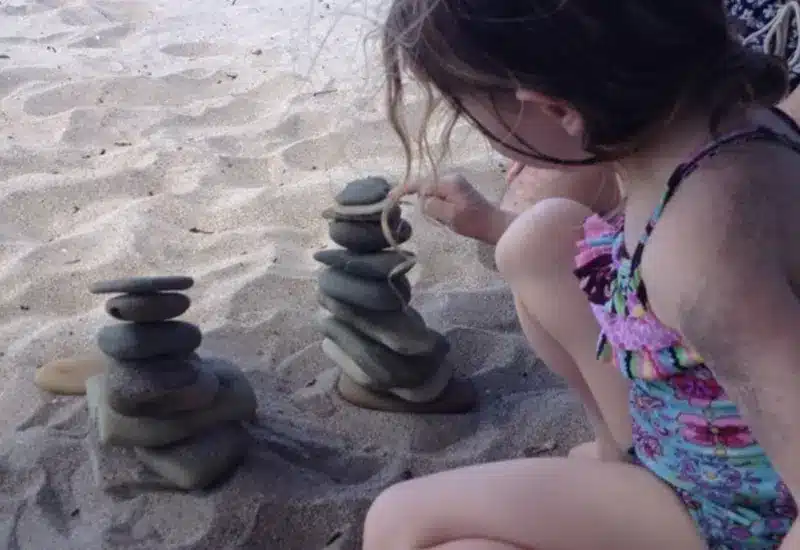
44. Stack Rocks
Stacking rocks is a calming outdoor activity that encourages concentration, patience, and problem-solving. Preschoolers can create their mini sculptures while learning about balance and symmetry.
Materials Needed:
- A variety of smooth rocks or stones (different sizes)
- A flat surface (like a rock pile or a smooth patch of ground)
How to Do It:
- Take your preschooler to an area with plenty of smooth, stackable rocks, such as a garden, park, or beach.
- Show them how to stack rocks carefully by placing a large one at the base and adding smaller ones on top.
- Encourage your child to create their rock towers or sculptures. You can add a challenge by seeing who can build the tallest or most stable tower.
- Discuss the concept of balance and gravity with your child while they build their rock stacks.
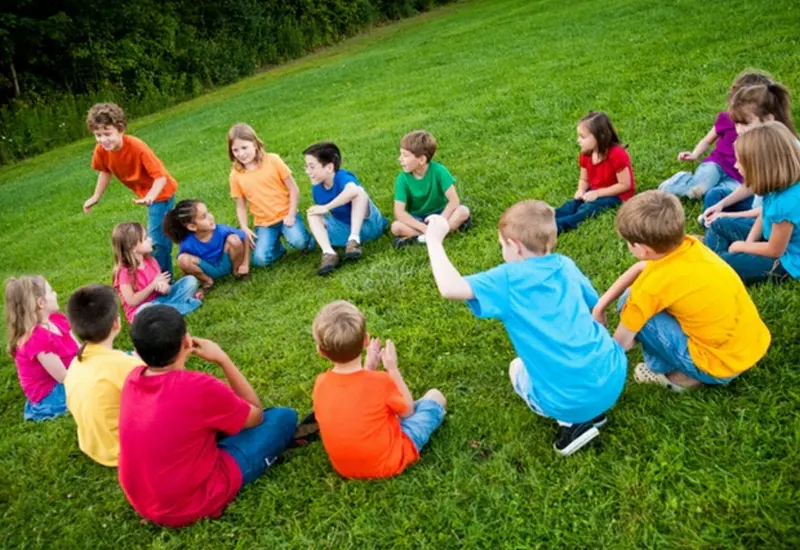
45. Play Duck, Duck, Goose
Duck, Duck, Goose is a classic outdoor game that promotes social interaction, following directions, and physical activity. Preschoolers enjoy this simple yet engaging game, where they take turns running, tapping heads, and playing with friends.
Materials Needed:
- No materials needed (just open space)
How to Do It:
- Have the children sit in a circle on the ground.
- One child walks around the circle, tapping the others on the head, saying “duck” each time.
- When they say “goose,” the child they tapped must jump up and try to catch the “tapper” before they can reach the empty space in the circle.
- The game continues with different children taking turns as the “tapper.”
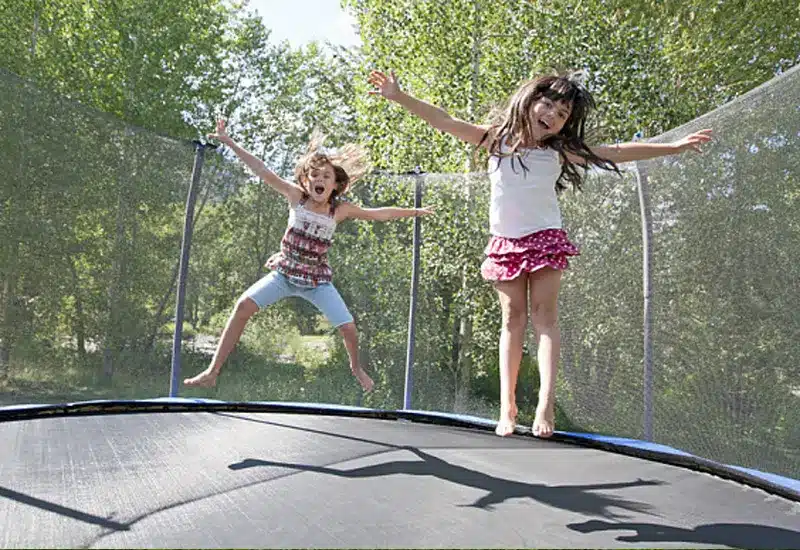
46. Jump on a Trampoline
Jumping on a trampoline is a high-energy activity that strengthens muscles, enhances coordination, and helps develop spatial awareness. It’s a fun way for preschoolers to burn off energy while improving their balance and motor skills.
Materials Needed:
- Trampoline (suitable for preschoolers)
- Safety net (if available, for added security)
- Comfortable clothing
How to Do It:
- Have your preschooler climb onto the trampoline and show them how to jump up and down with both feet.
- Encourage them to bounce differently—try jumping with their feet together, hopping on one foot, or spinning in place.
- If you have a safety net around the trampoline, let them jump freely. Always supervise to ensure safety during play.
- Challenge them to jump as high as possible or bounce in a rhythm, increasing coordination.
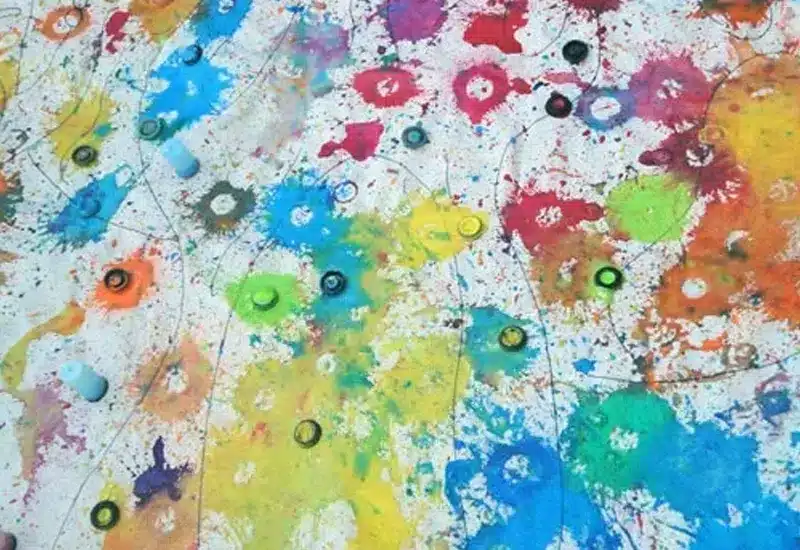
47. Explode Paint Bombs
Creating paint bombs is a messy but fun way for preschoolers to explore colors and creative expression. It also helps develop motor skills and coordination as they make a splash with vibrant paint!
Materials Needed:
- Small water balloons
- Fabric paint or washable paint
- Plastic drop cloth (for easy cleanup)
How to Do It:
- Fill small water balloons with fabric paint or washable paint.
- Have your preschooler throw the balloons onto a large canvas or cloth.
- Watch as the paint explodes, creating colorful splatters and patterns.
- Allow your child to explore the different colors and experiment with mixing paints to make new shades.
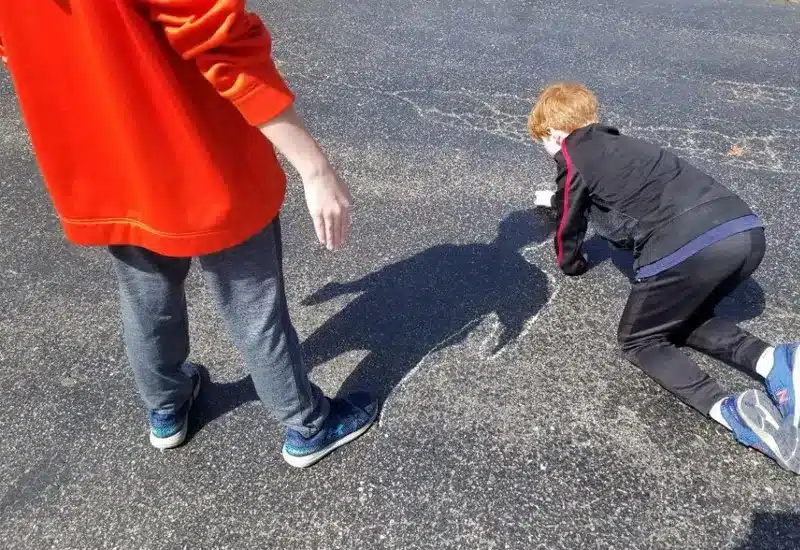
48. Shadow Painting
Shadow painting is a fun outdoor activity that introduces preschoolers to the concept of light and shadow. By using natural light, they can create beautiful art while learning how shadows shift and change throughout the day.
Materials Needed:
- White paper or cardboard
- Various objects to create shadows (toys, plants, or even hands)
- Markers, crayons, or paint
- A sunny outdoor area
How to Do It:
- On a sunny day, set up white paper or cardboard outside in a place where the light will cast clear shadows.
- Place objects, like toys, figurines, or even your child’s hands, on the paper to create interesting shadows.
- Have your preschooler trace the shadows with markers or crayons.
- Encourage them to fill in the shadow shapes with paint or coloring materials, creating a beautiful and colorful shadow art piece.
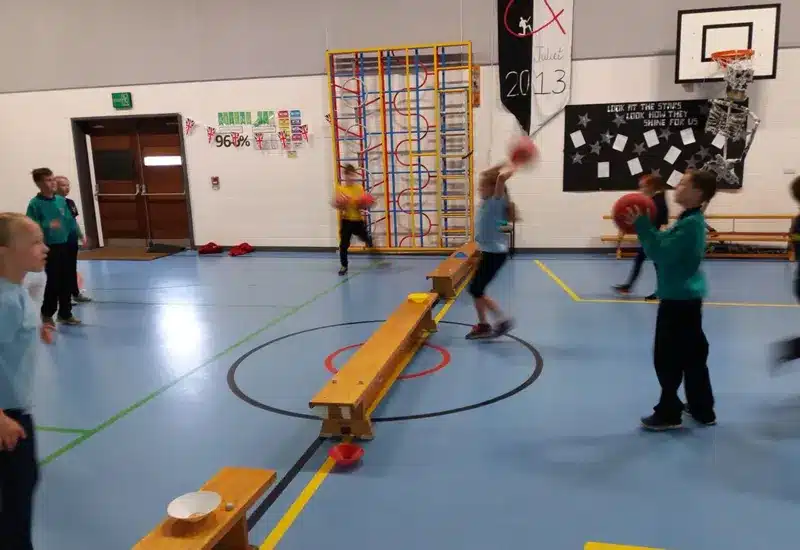
49. Bench Ball
Bench Ball is a team sport that involves passing a ball to teammates and trying to score by hitting a target, such as a bench. It helps preschoolers develop teamwork, hand-eye coordination, and physical fitness while having fun.
Materials Needed:
- A softball (preferably a lightweight ball for safety)
- A bench or any target (such as a large object)
- Cones or markers to define the playing area
How to Do It:
- Divide your preschoolers into two teams.
- Set a target, such as a bench or chair, at the center of a safe, open space.
- The objective is for each team to pass the ball to their teammates, avoid the other team, and try to hit the target by throwing or rolling the ball.
- If the ball hits the target, the team scores a point. Keep playing by rotating teams, and encourage sportsmanship and teamwork.
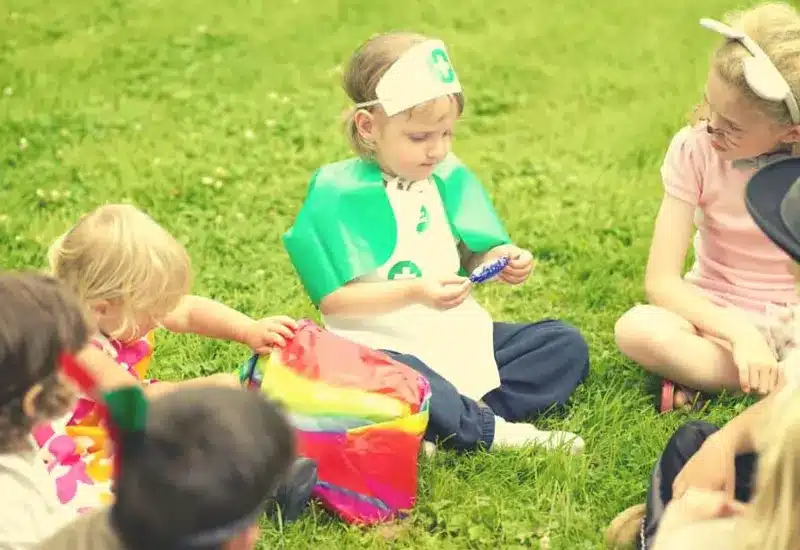
50. Splash Out Hot Potato
Splash Out Hot Potato is a fun and energetic game where preschoolers pass a water balloon around, trying not to be the one holding it when it bursts. This game helps improve teamwork, coordination, and reflexes, all while keeping kids cool during warm weather.
Materials Needed:
- Water balloons
- Towels (for drying off)
- An open outdoor space
How to Do It:
- Fill several water balloons and gather your preschoolers in a circle.
- Start by handing one balloon to the first child and have them pass it to the next person as quickly as possible.
- Continue passing the balloon around, trying not to burst it. The child holding the balloon when it bursts is out of the game.
- You can add challenges by having children pass the balloon using only one hand or by jumping while passing the balloon.

51. Build a Fairy House
Building a fairy house is a delightful and imaginative outdoor activity that encourages creativity and fosters a connection with nature. Preschoolers can use natural materials to create a magical little house for fairies, learning about ecosystems and sustainability in the process.
Materials Needed:
- Twigs, leaves, pinecones, and rocks
- Moss, flowers, or grass
- Small container (optional for structure)
- String (optional for decoration)
How to Do It:
- Take your preschooler to the backyard, garden, or park and encourage them to gather natural materials like twigs, leaves, and flowers.
- Help them arrange the materials into a small house structure. Using large leaves, you can create a little roof or cover the floor with moss for a soft base.
- Decorate the house with flowers, small stones, or ribbons to make it look magical.
- Encourage them to imagine fairies living in the house and tell stories about the fairy kingdom.
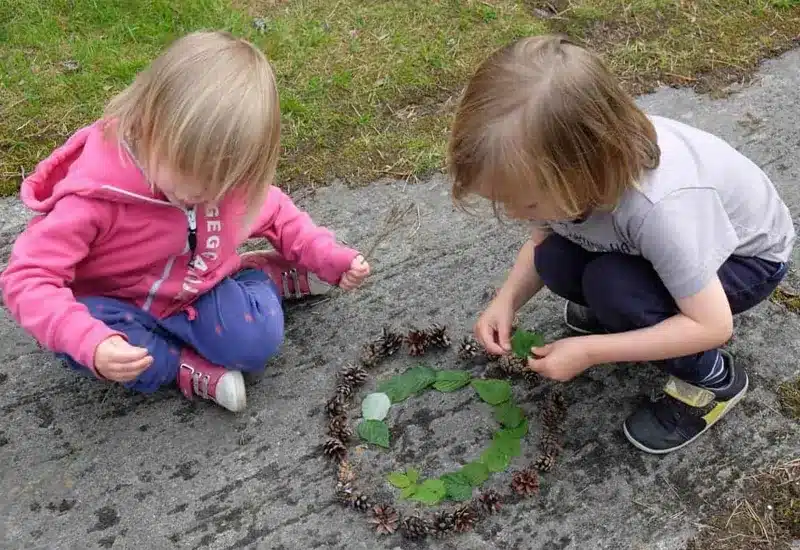
52. Create a Mandala
Creating a mandala is a peaceful and meditative outdoor activity that allows preschoolers to practice pattern recognition and creativity. This activity also enhances fine motor skills as children arrange natural materials into symmetrical designs.
Materials Needed:
- Leaves, flowers, rocks, and other natural objects
- A large piece of paper or flat surface (optional)
How to Do It:
- Lay a large piece of paper or cardboard on the ground, or simply find a flat surface outside to work on.
- Encourage your child to arrange natural materials, such as leaves, flowers, or rocks, into circular patterns, forming a mandala shape.
- Explain the concept of symmetry and balance while helping them create their designs.
- Let them experiment with different colors, shapes, and patterns while building the mandala, enhancing their focus and creativity.
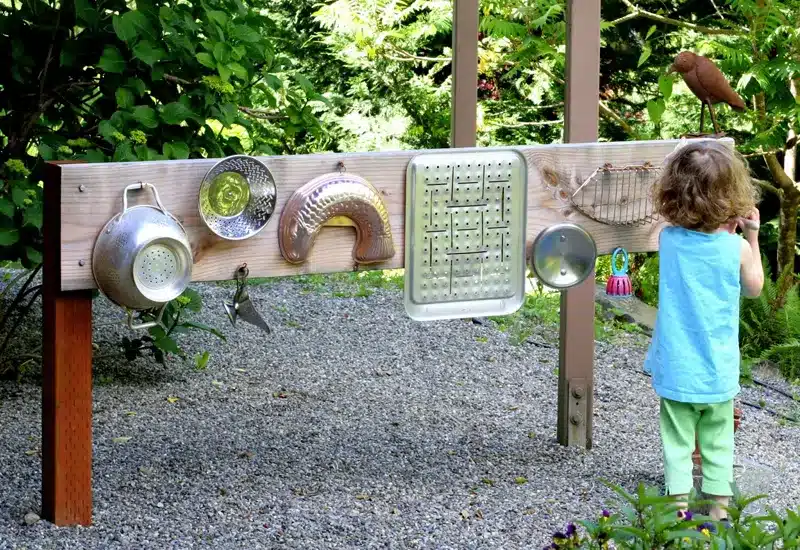
53. Outdoor Music Station
An outdoor music station is a fun and sensory-rich activity that introduces preschoolers to the joys of sound and music. Using simple, everyday objects, children can create their own instruments and experiment with different sounds and rhythms.
Materials Needed:
- Pots, pans, or buckets
- Wooden spoons or sticks
- Empty bottles (for percussion)
- Chimes or bells (optional)
- Old lids or metal objects (optional)
How to Do It:
- Set up an outdoor music station using a variety of objects that make sound. Pots and pans can be used as drums, while wooden spoons or sticks can serve as drumsticks.
- Show your preschooler how to tap, bang, or shake the objects to create different rhythms.
- Encourage them to experiment with different objects to see how each one produces a unique sound.
- You can also teach them simple songs or rhythmic patterns to follow, and invite them to create their own music by combining sounds in creative ways.
What Safety Precautions Should You Take When Planning Outdoor Activities for Preschoolers?
Planning outdoor activities for preschoolers is fun, but safety must come first. Young children are still learning to navigate their environment and can be more prone to accidents. Here are essential safety precautions to keep in mind when preparing outdoor activities:
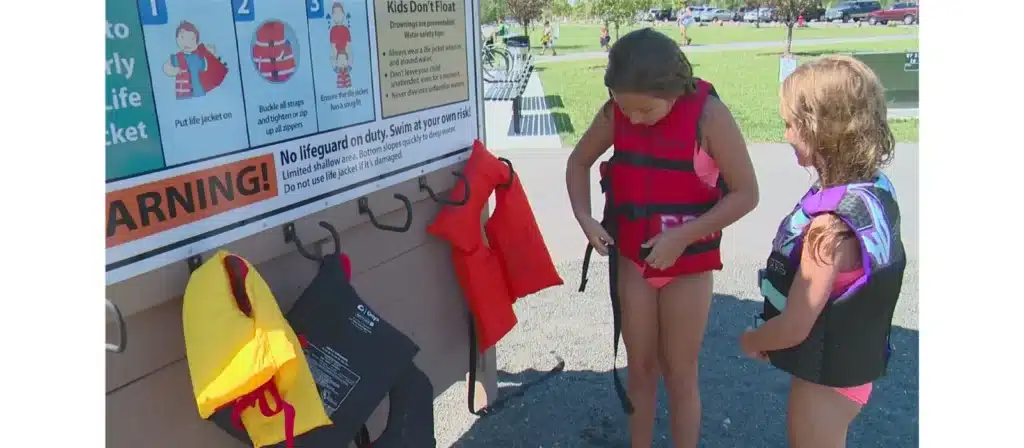
- Inspect the Play Area Thoroughly: Before starting any outdoor activity, assessing the area for potential hazards is crucial. Look for sharp objects like glass or nails, uneven terrain that could cause tripping, and toxic plants or insects that could pose a risk. Ensure that playground equipment is sturdy and in good repair.
- Supervise Constantly: One of the most effective ways to prevent accidents is constant supervision. No matter how safe they seem, outdoor play areas always require adult monitoring. Keep an eye on kids climbing, running, or participating in activities that could lead to a fall or injury. For activities like gross motor skills outdoor activities for preschoolers—which often involve jumping, balancing, or climbing—adults should always be within arm’s reach in case a child needs help or loses balance.
- Teach Preschoolers About Outdoor Safety: Even though young, preschoolers can still understand basic safety rules. Before starting an activity, take a few minutes to explain any potential risks and how to avoid them.
- Use Age-Appropriate Equipment: When setting up activities, always ensure the equipment is suitable for the children’s age and abilities. Preschoolers can be eager to try everything, but not all play equipment is safe for their developmental level; even in outdoor art activities for preschoolers, safety matters. Use non-toxic paints and ensure the setup is sturdy, with tables and chairs at the right height for kids to sit comfortably without tipping over.
- Create Safe Boundaries: Setting boundaries during outdoor activities helps preschoolers understand where they can and cannot go. Whether you’re in a backyard, park, or nature area, establish clear limits and make sure kids know not to wander too far.
- Be Prepared for Emergencies: Even with the best precautions, accidents can still happen, so it’s essential to be prepared for emergencies. Always have a first-aid kit handy and know basic first-aid procedures.
- Hydration and Snack Breaks: Children can become dehydrated quickly, especially when engaging in physical activities like gross motor outdoor activities for preschoolers or outdoor spring activities for preschoolers.
- Avoid Overcrowded Spaces: While parks and playgrounds are great for outdoor play, they can become overcrowded, increasing the risk of accidents.
More Related Questions
- What types of outdoor activities are best for preschool motor skill development?
Outdoor activities involving running, jumping, and climbing—such as obstacle courses or balancing games—improve motor skills. - How do nature activities benefit emotional development in children?
Spending time in nature has a calming effect on children, helping to reduce stress and anxiety. Activities like gardening or bird watching provide a peaceful environment for children to reflect and connect with nature. - What educational concepts can be taught through outdoor play?
Outdoor play can introduce kids to math (counting objects), science (observing plant and animal life), and language (describing their surroundings). It’s a versatile environment for learning across multiple subjects. - How can outdoor play encourage independence in preschoolers?
Outdoor activities allow children to take risks, make decisions, and solve problems independently. For example, they’ll have to use their creativity and judgment without constant adult guidance in a treasure hunt or fort-building activity. - How often should preschoolers engage in outdoor activities?
Experts recommend preschoolers have at least one to two hours of outdoor play daily. Regular outdoor time ensures a balance between structured learning and free play. - Can outdoor play help preschoolers focus better in the classroom?
Yes! Research shows that outdoor play helps children release energy and return to indoor activities with better focus and attention. It’s a great way to prevent restlessness and improve academic performance later in the day.
Conclusion
Outdoor activities for preschoolers provide countless benefits for children. Kids gain confidence and improve their mental health. Nature becomes a classroom where creativity and focus flourish. Parent shared,
“The outdoor program has super inspired my children! They are having a great time hiking, learning hands-on science, nature journaling, art, and making new friends.”
Try these activities with your children. They will create lasting memories and foster a love for learning. Embrace the outdoors and watch your child’s curiosity and joy grow.



